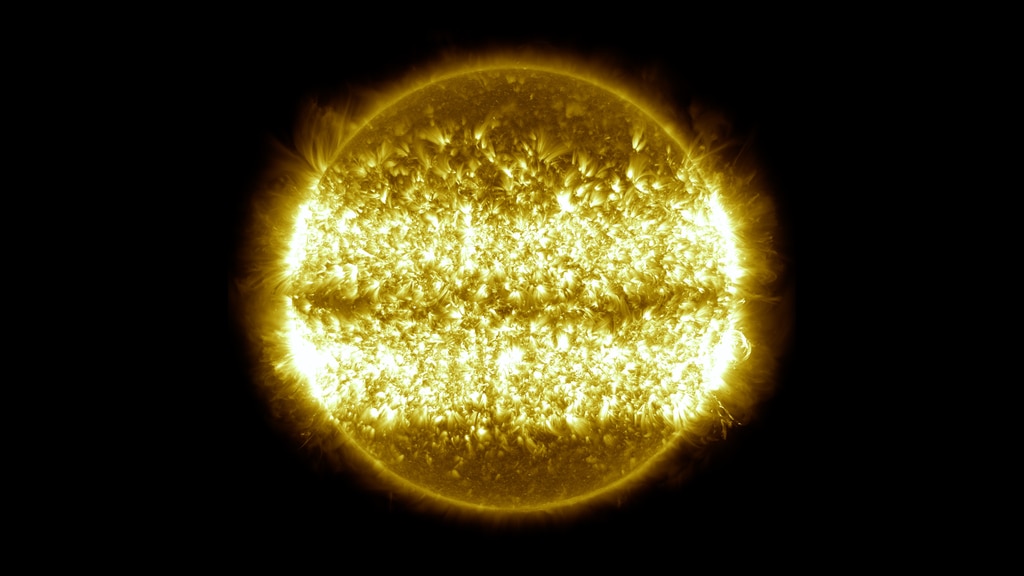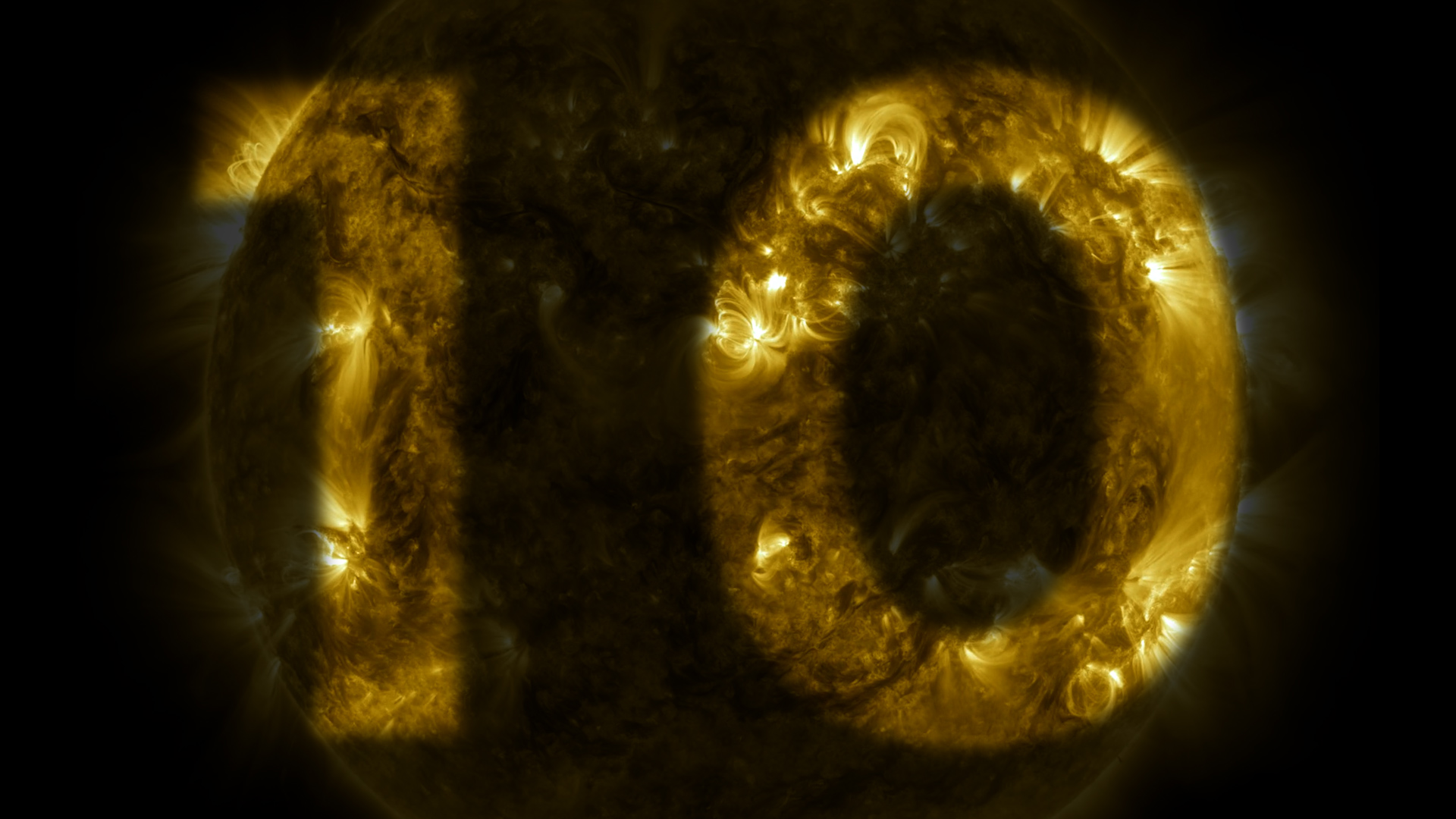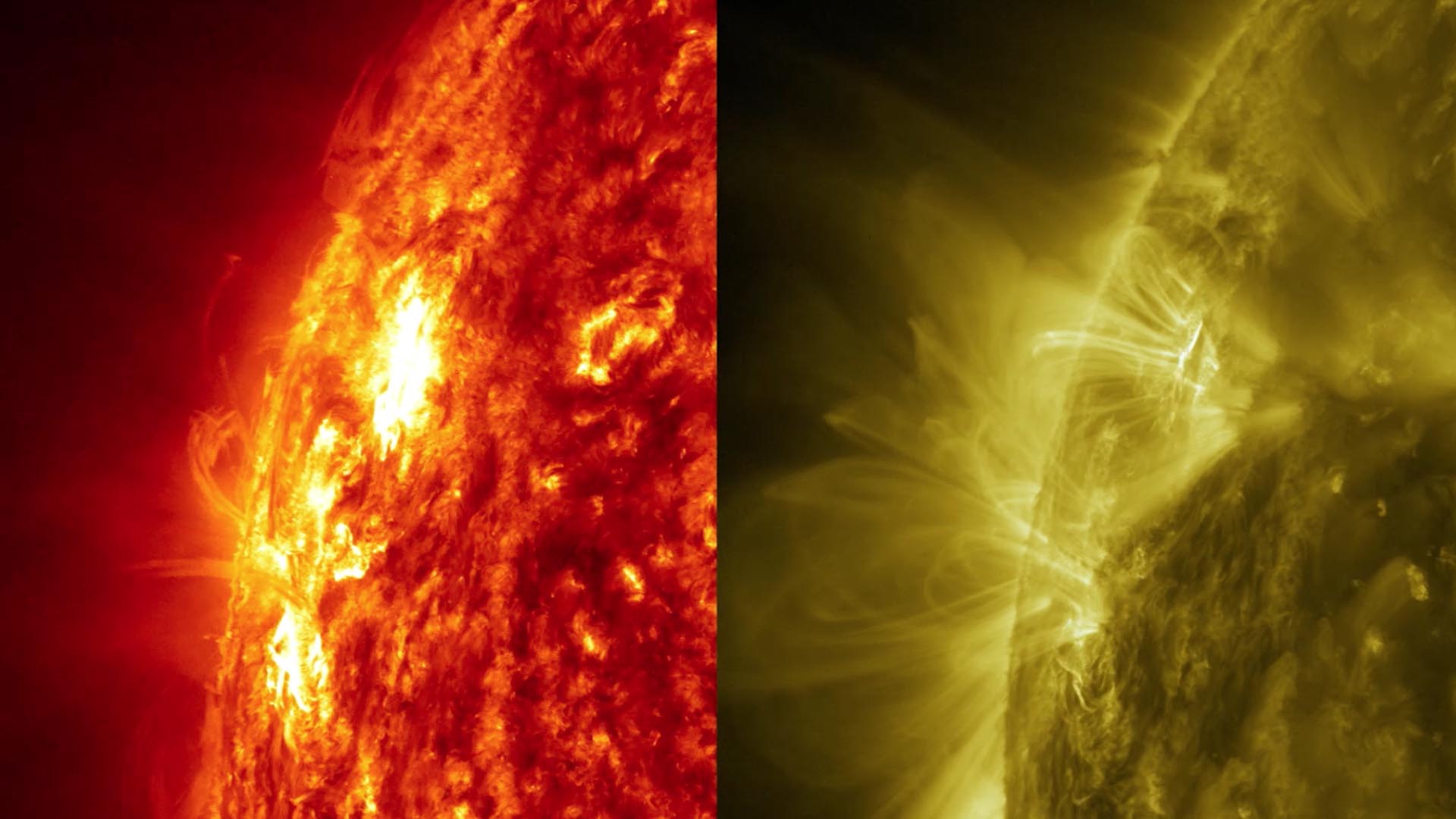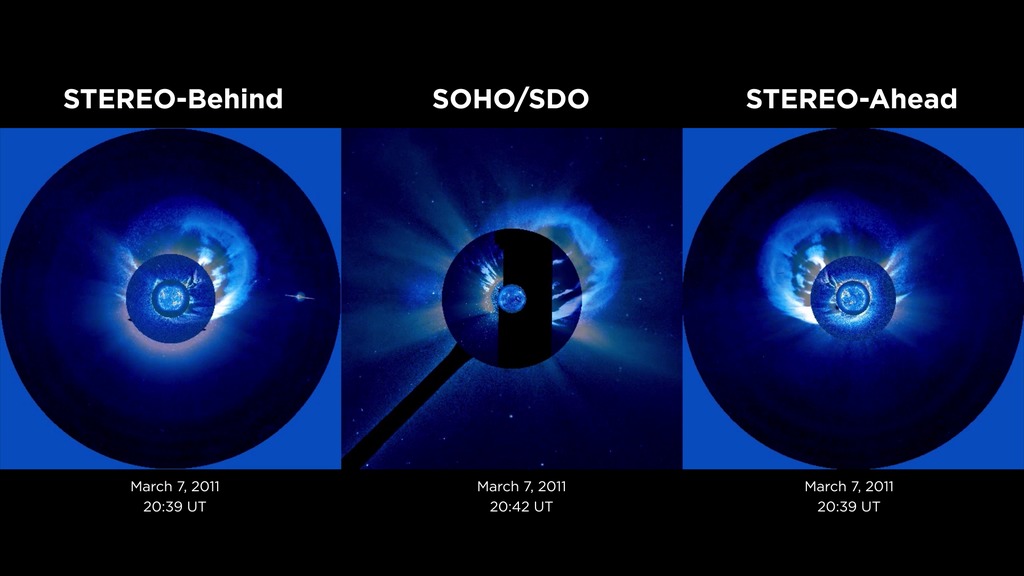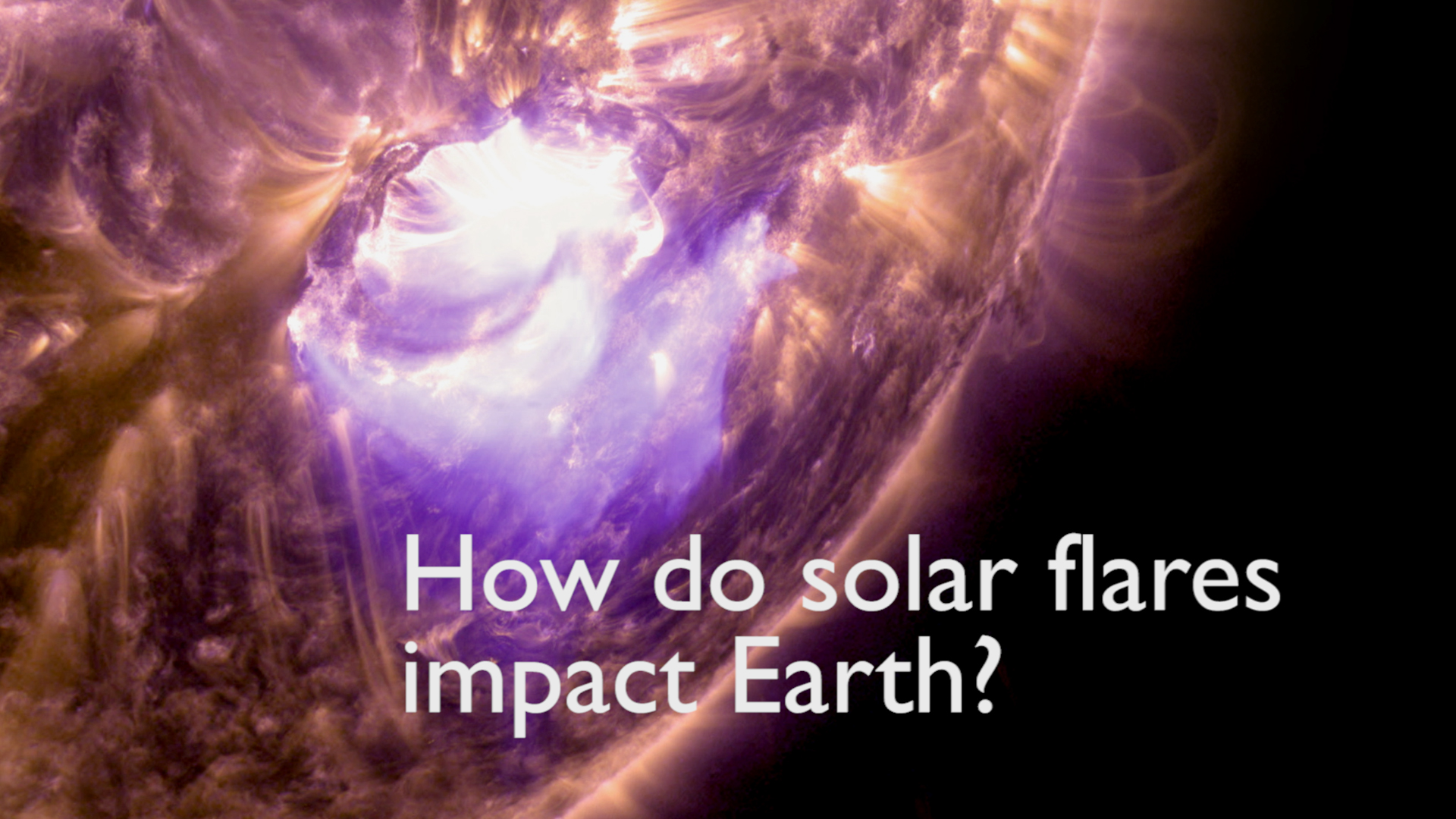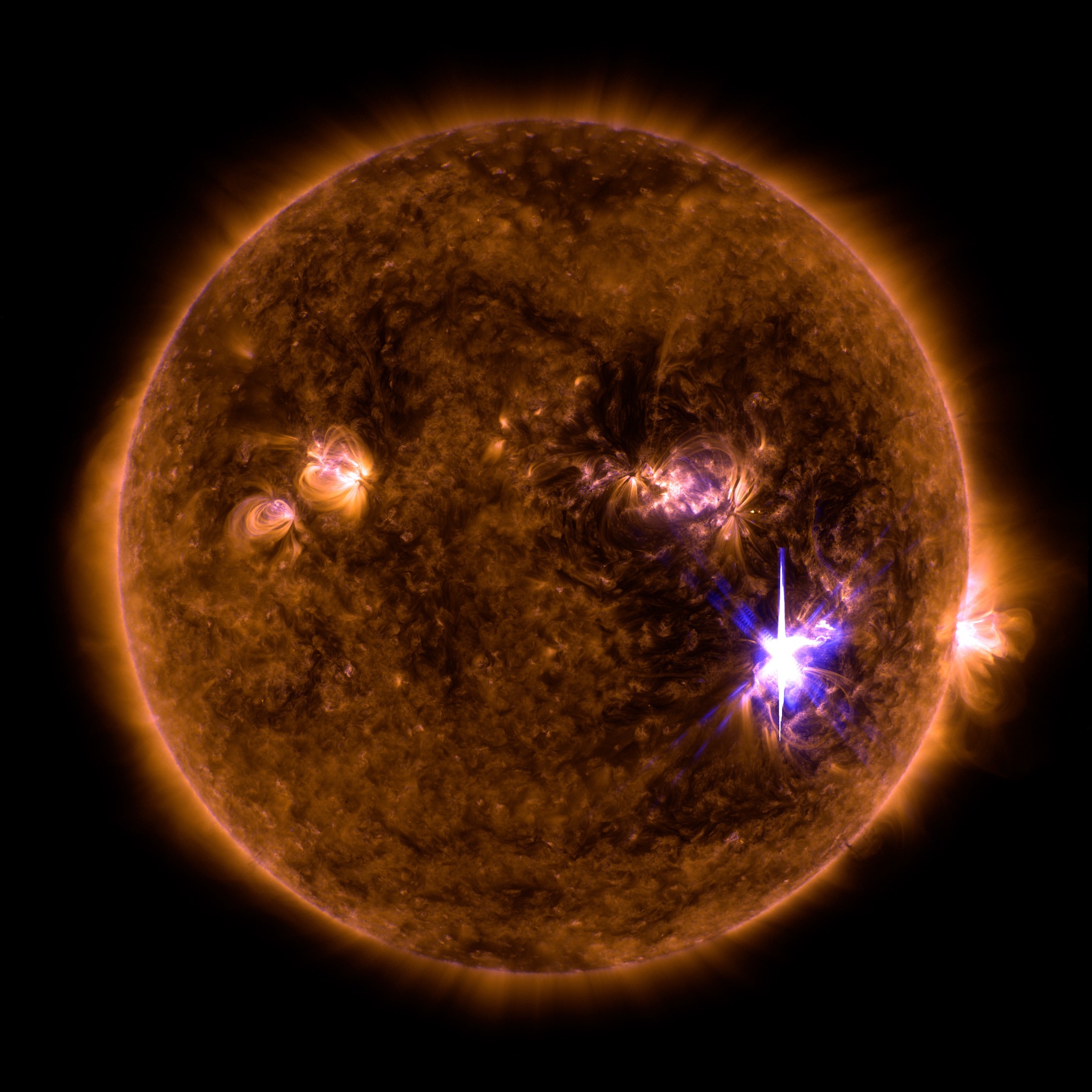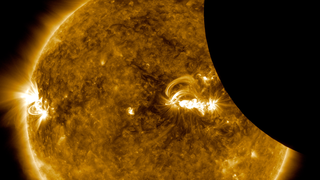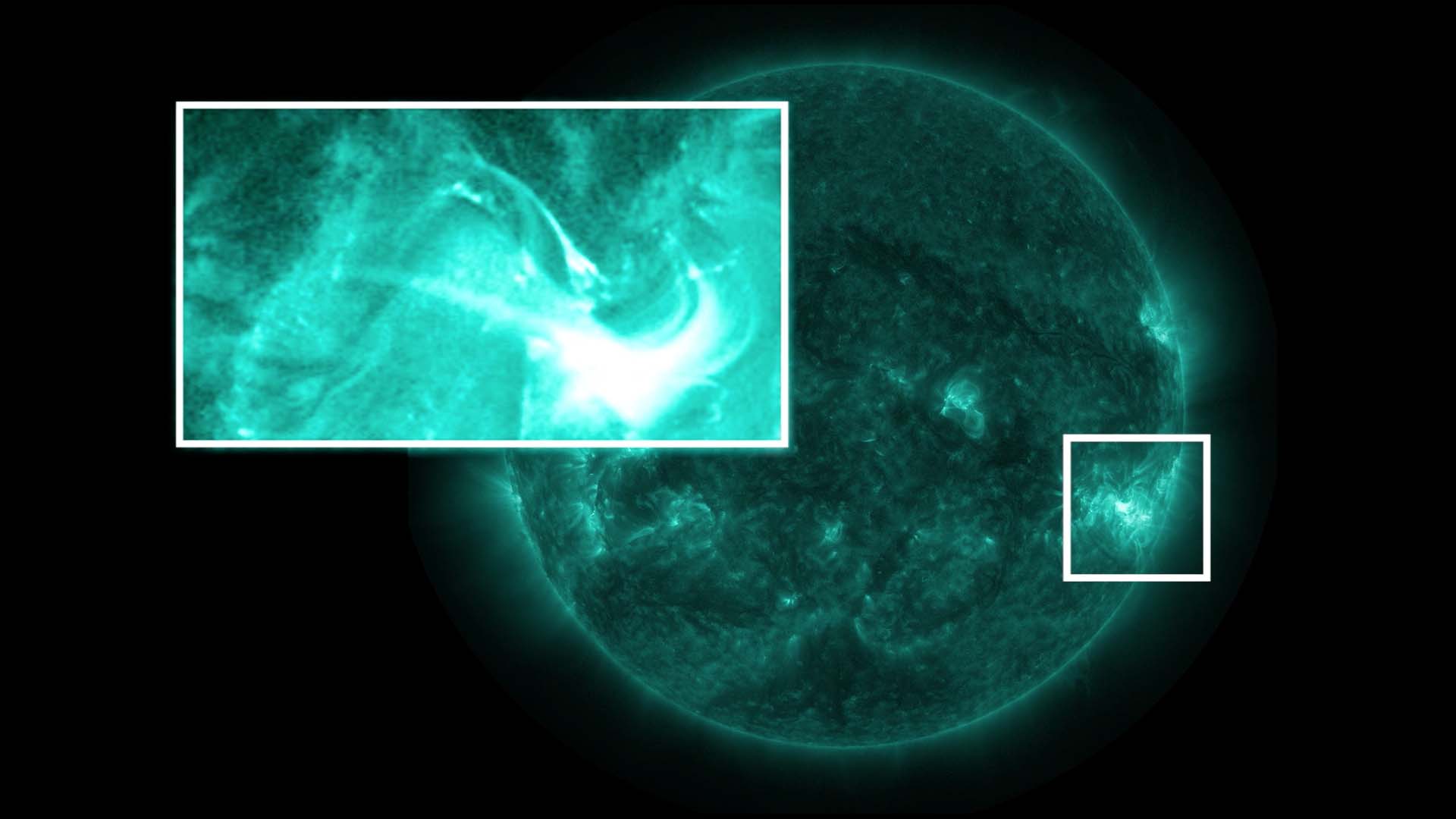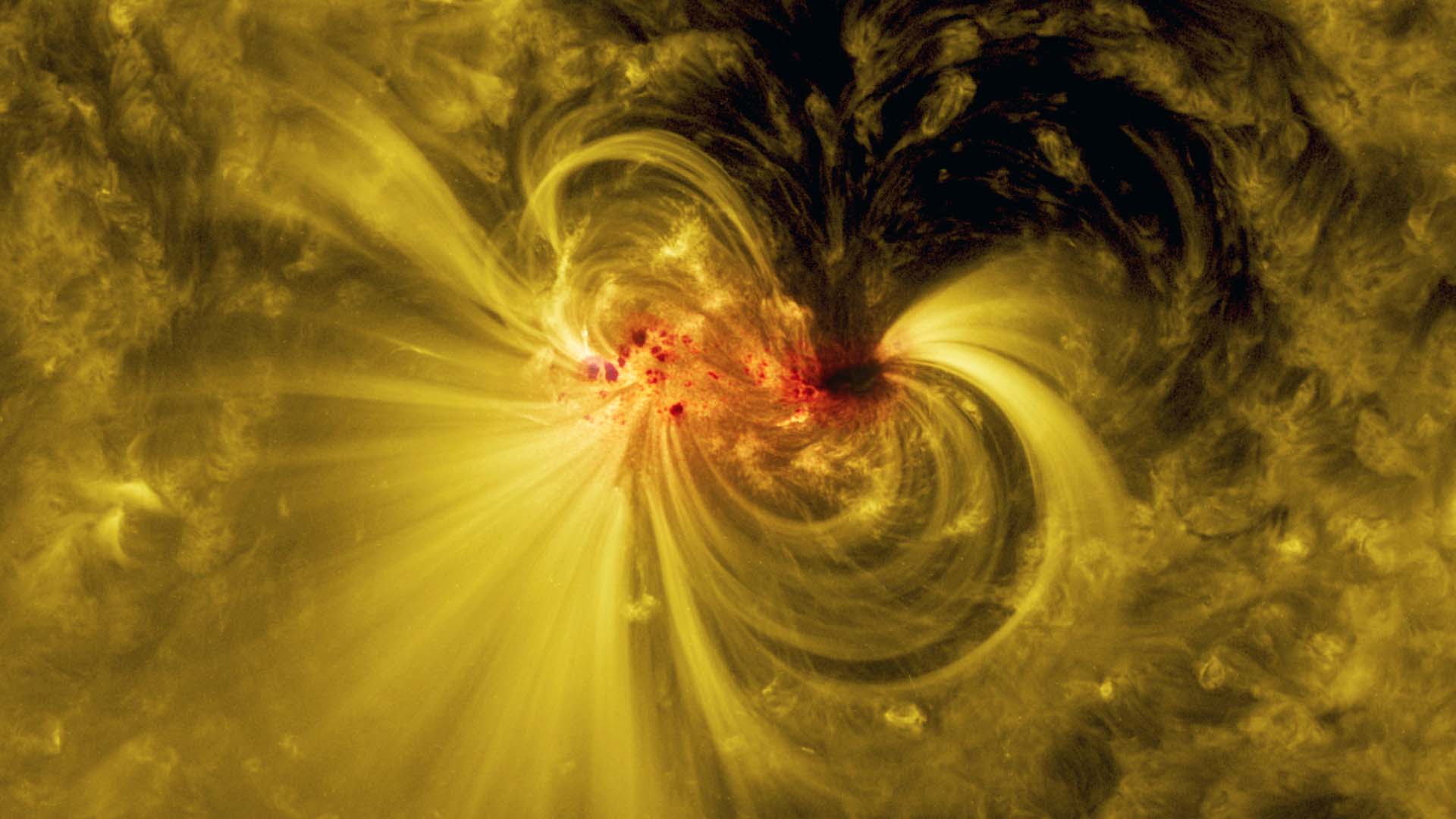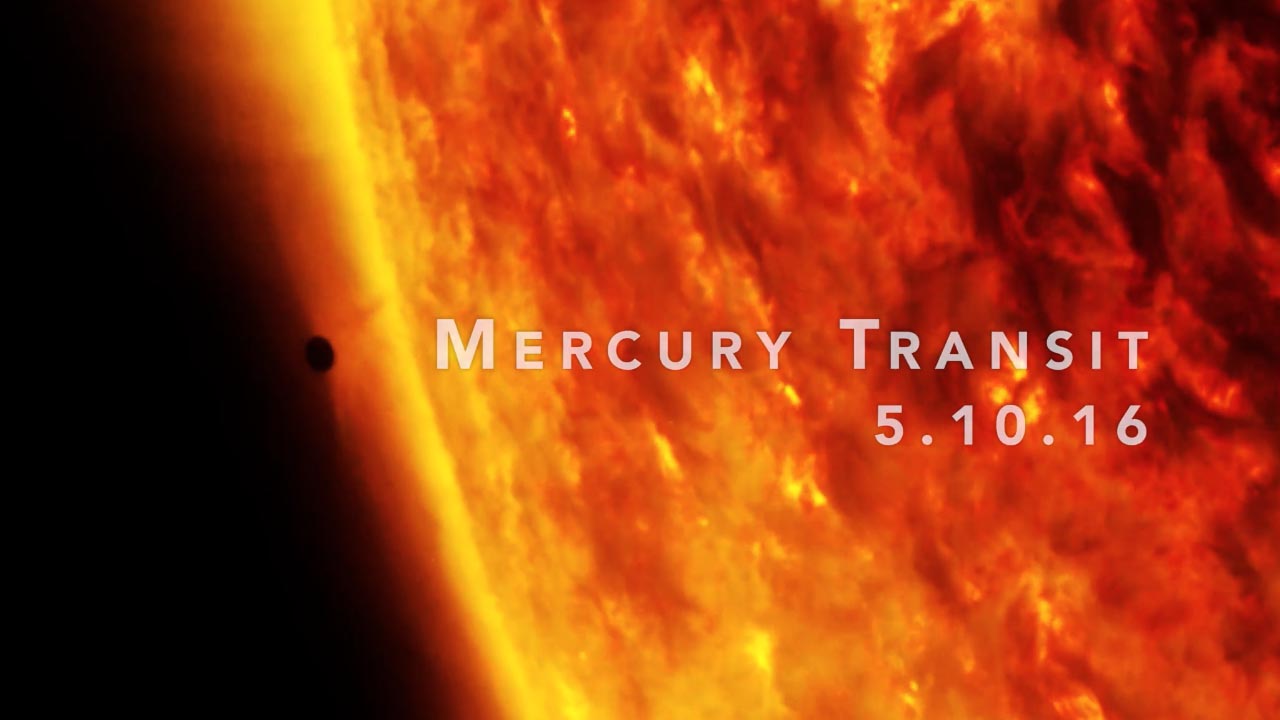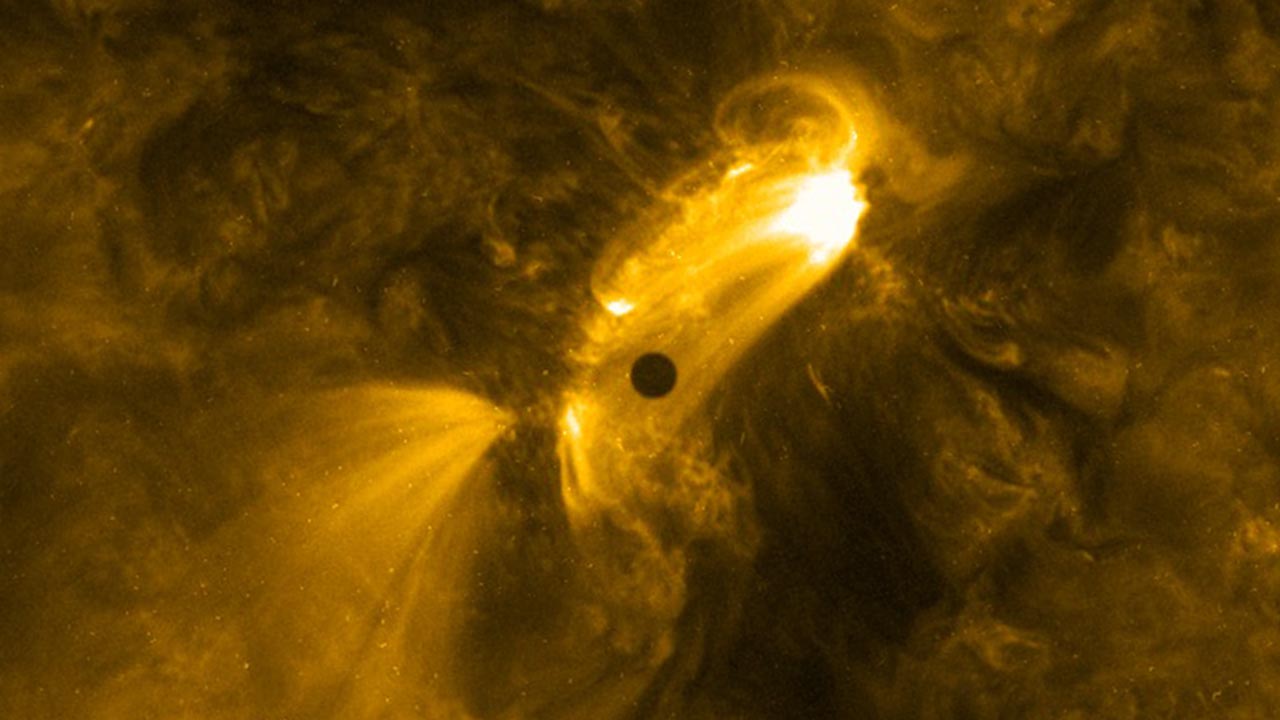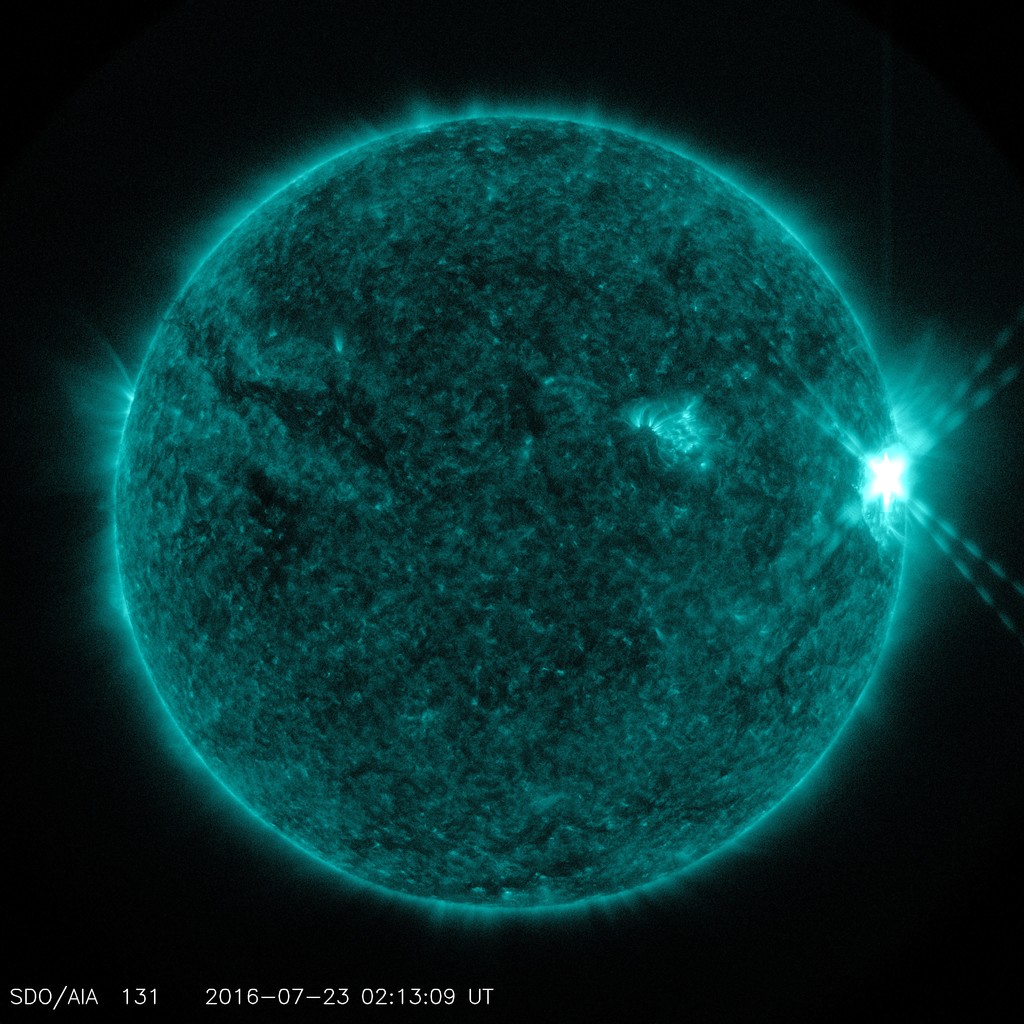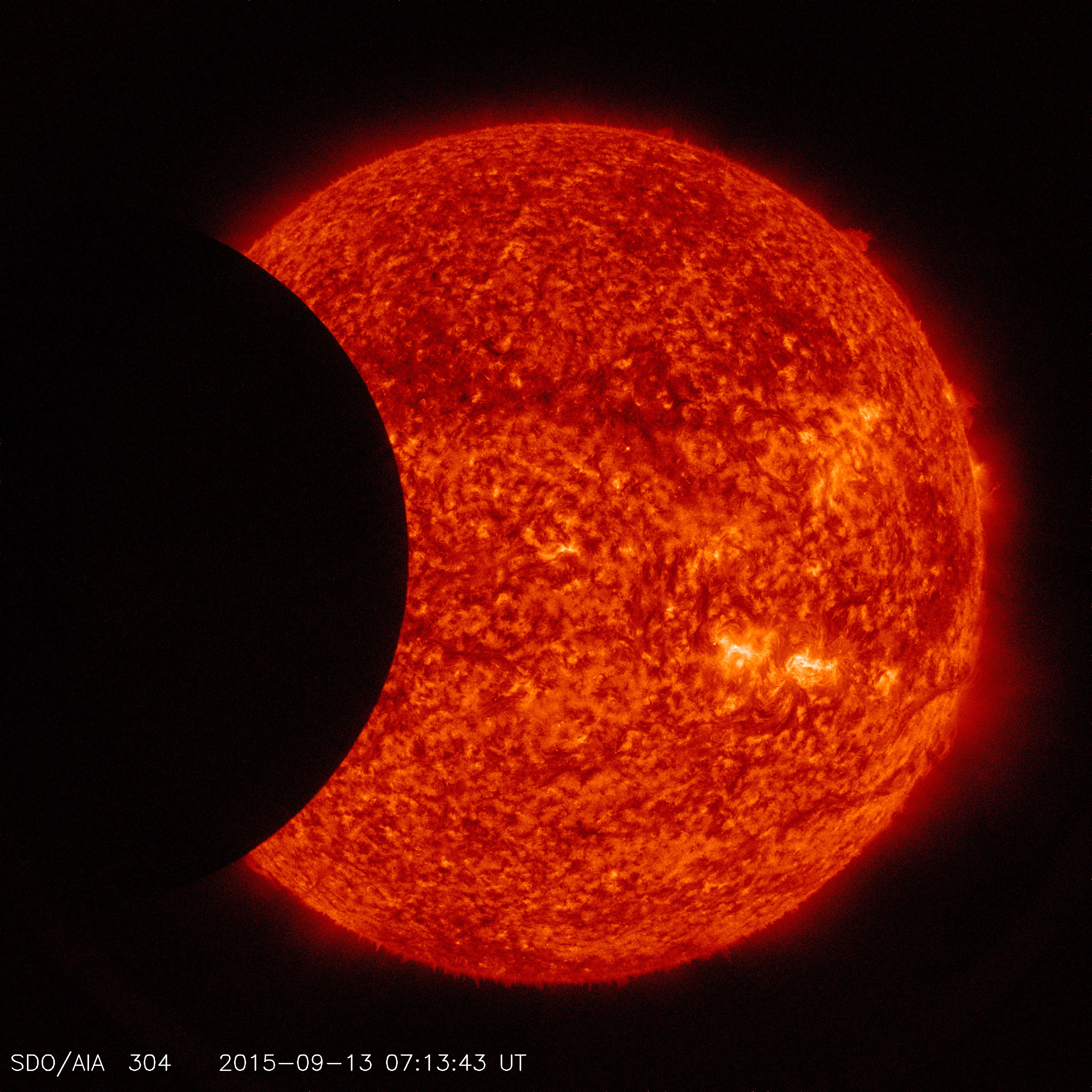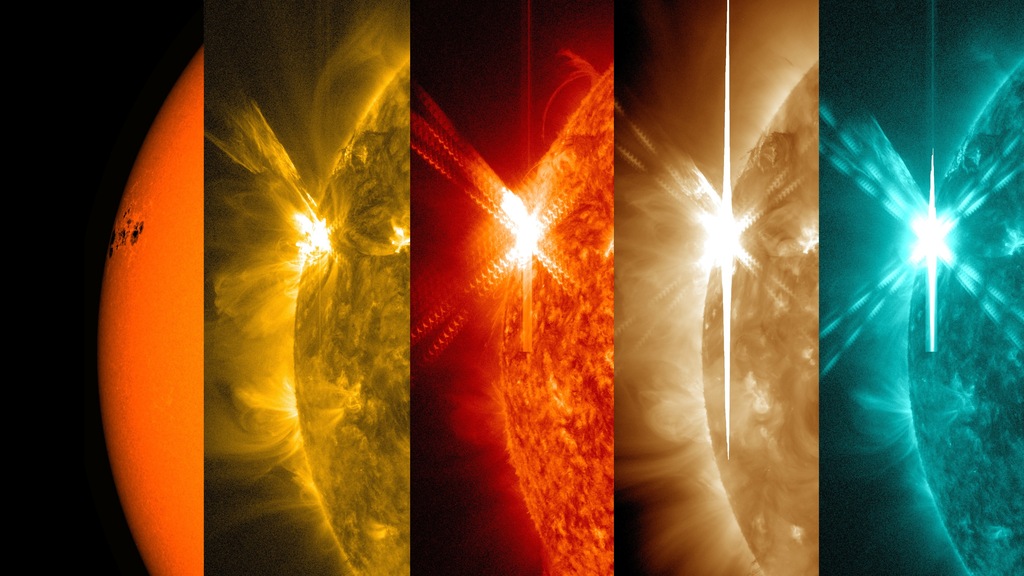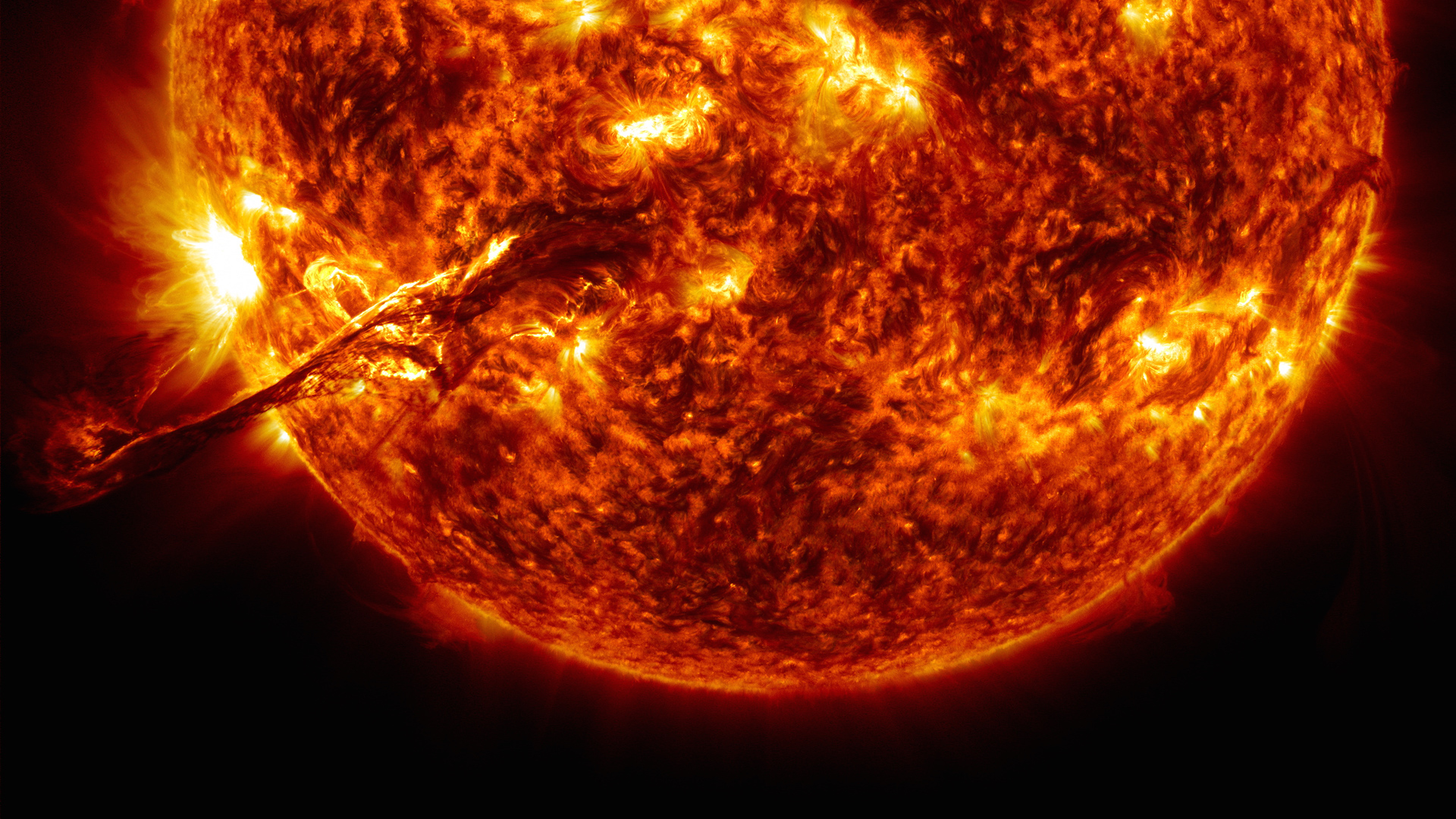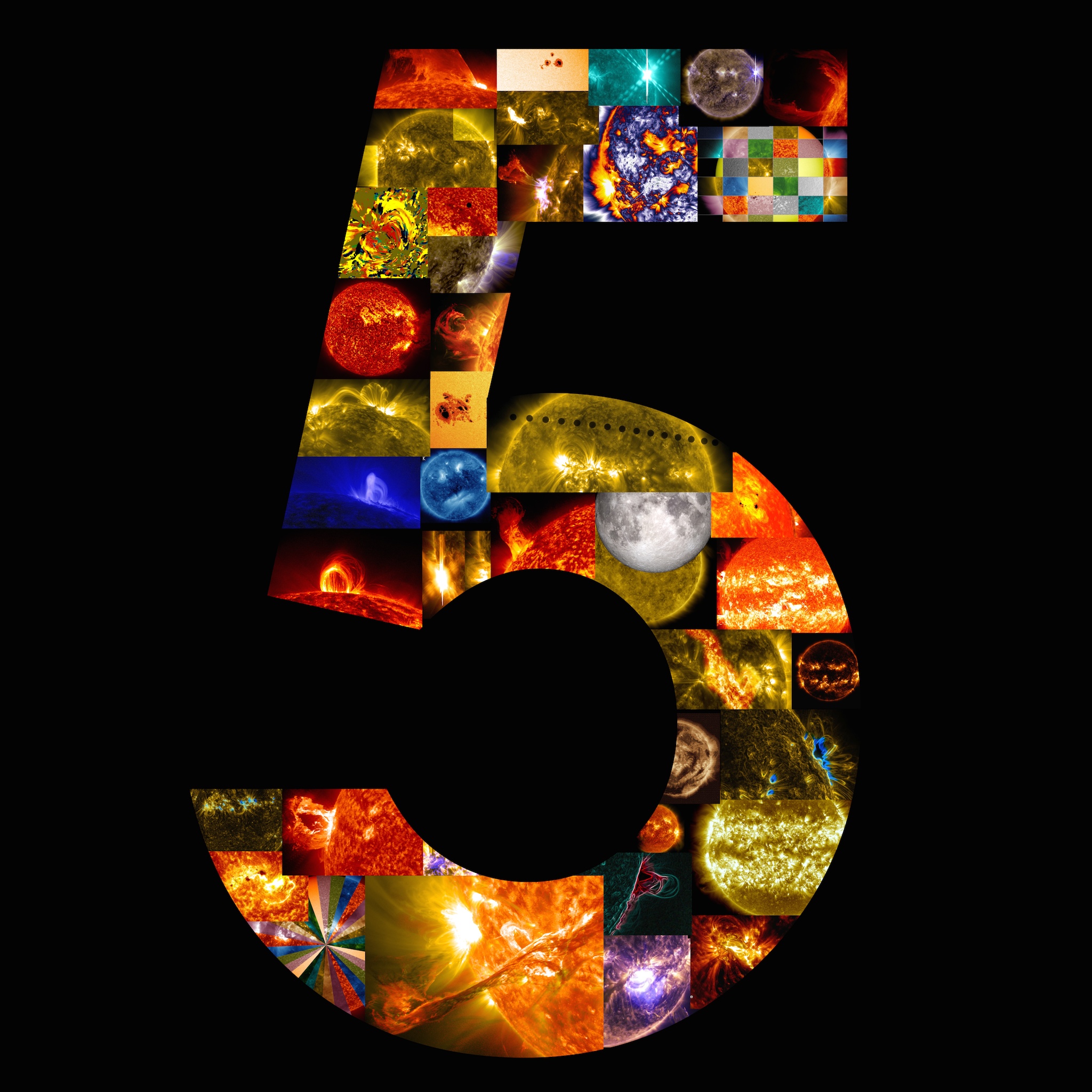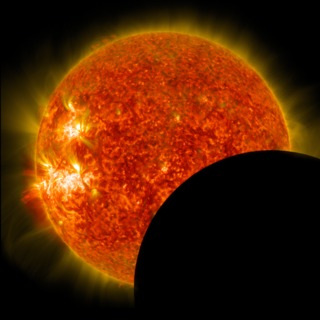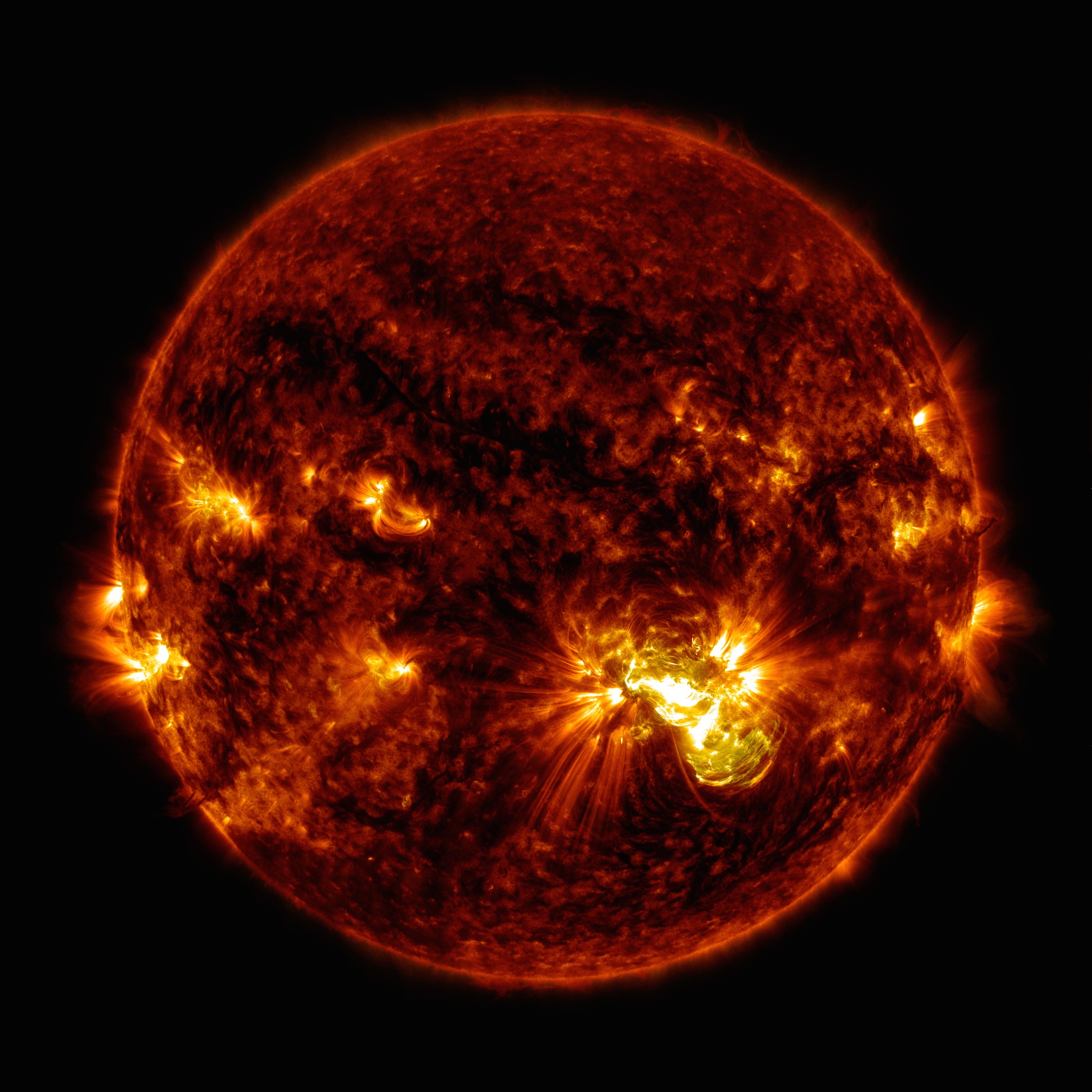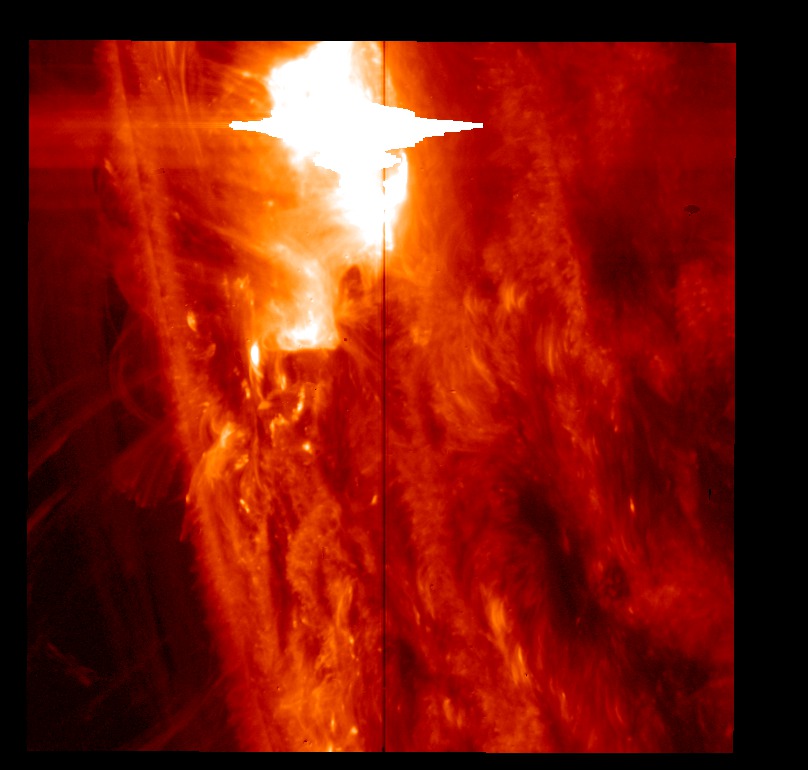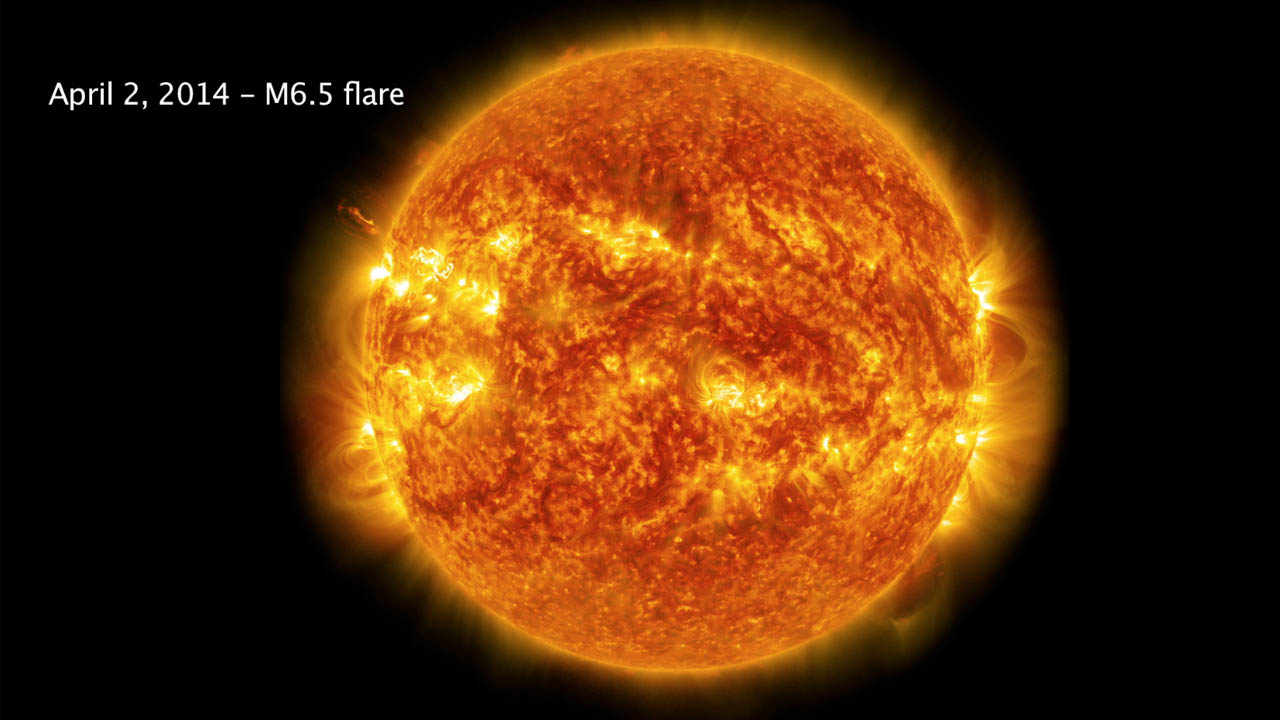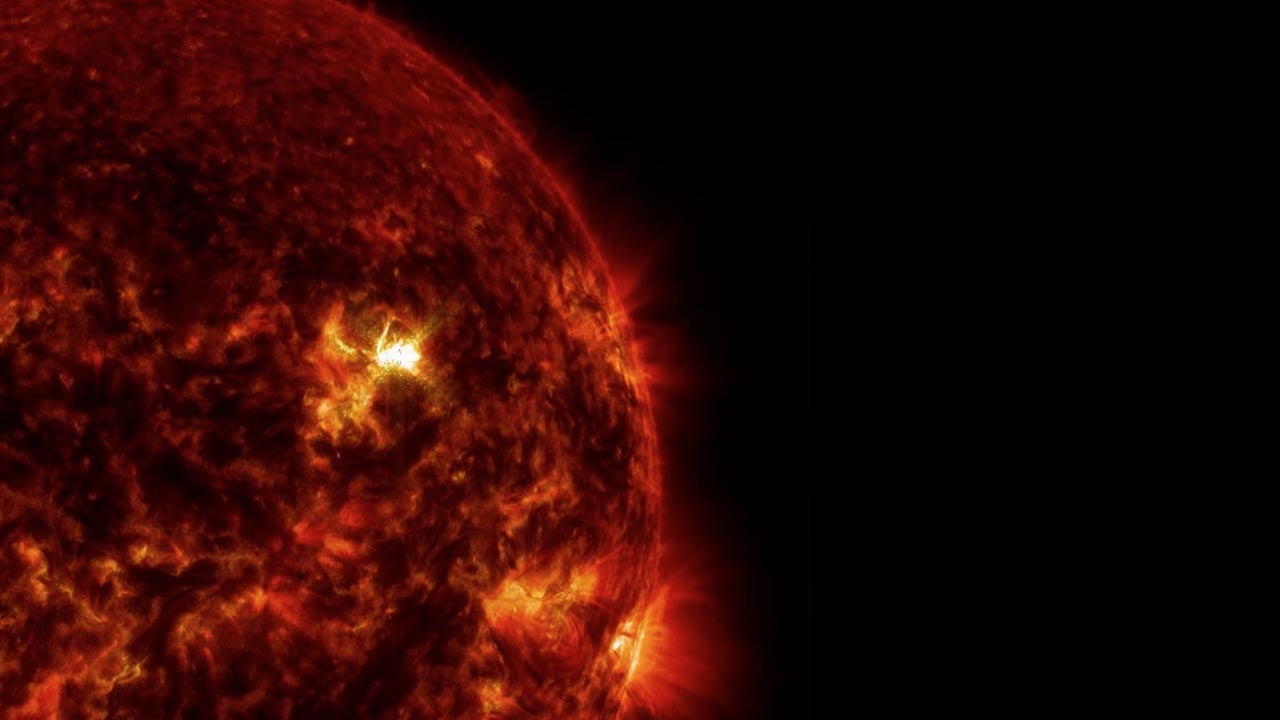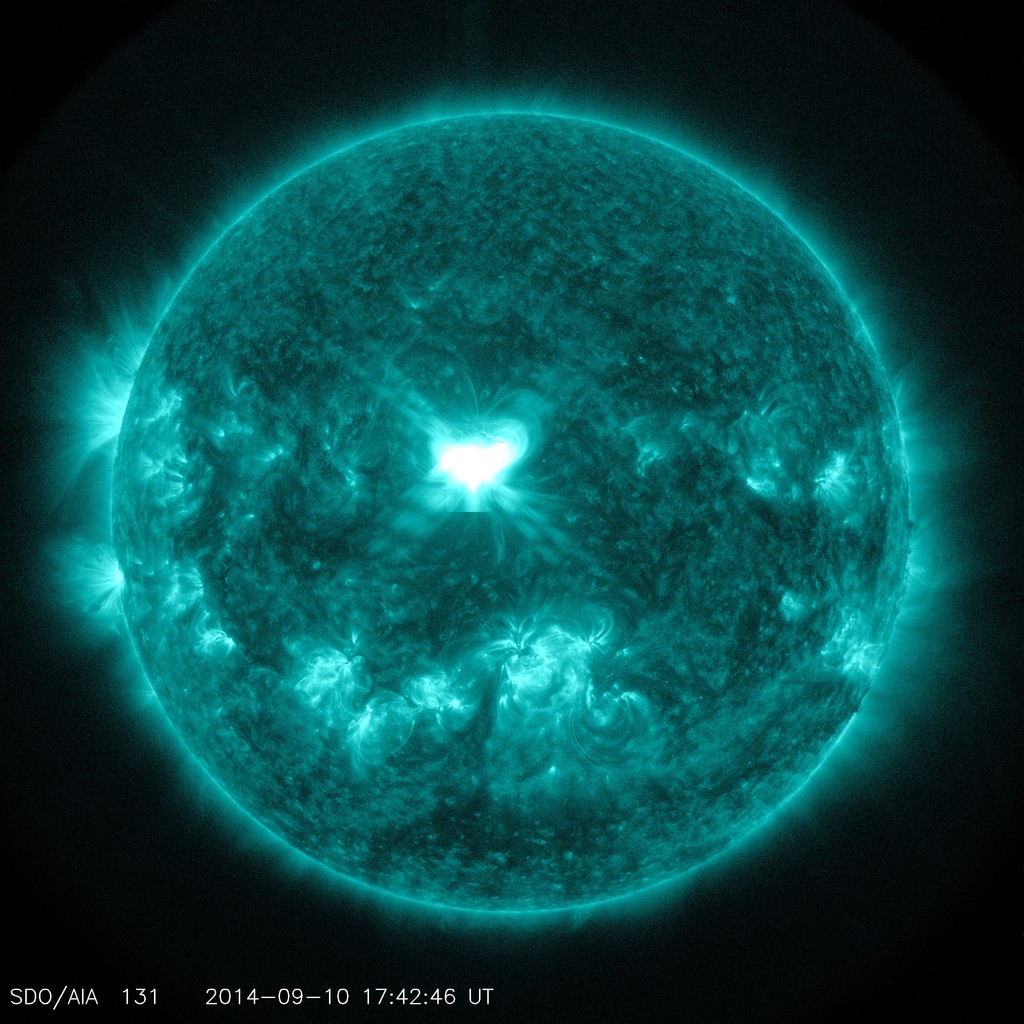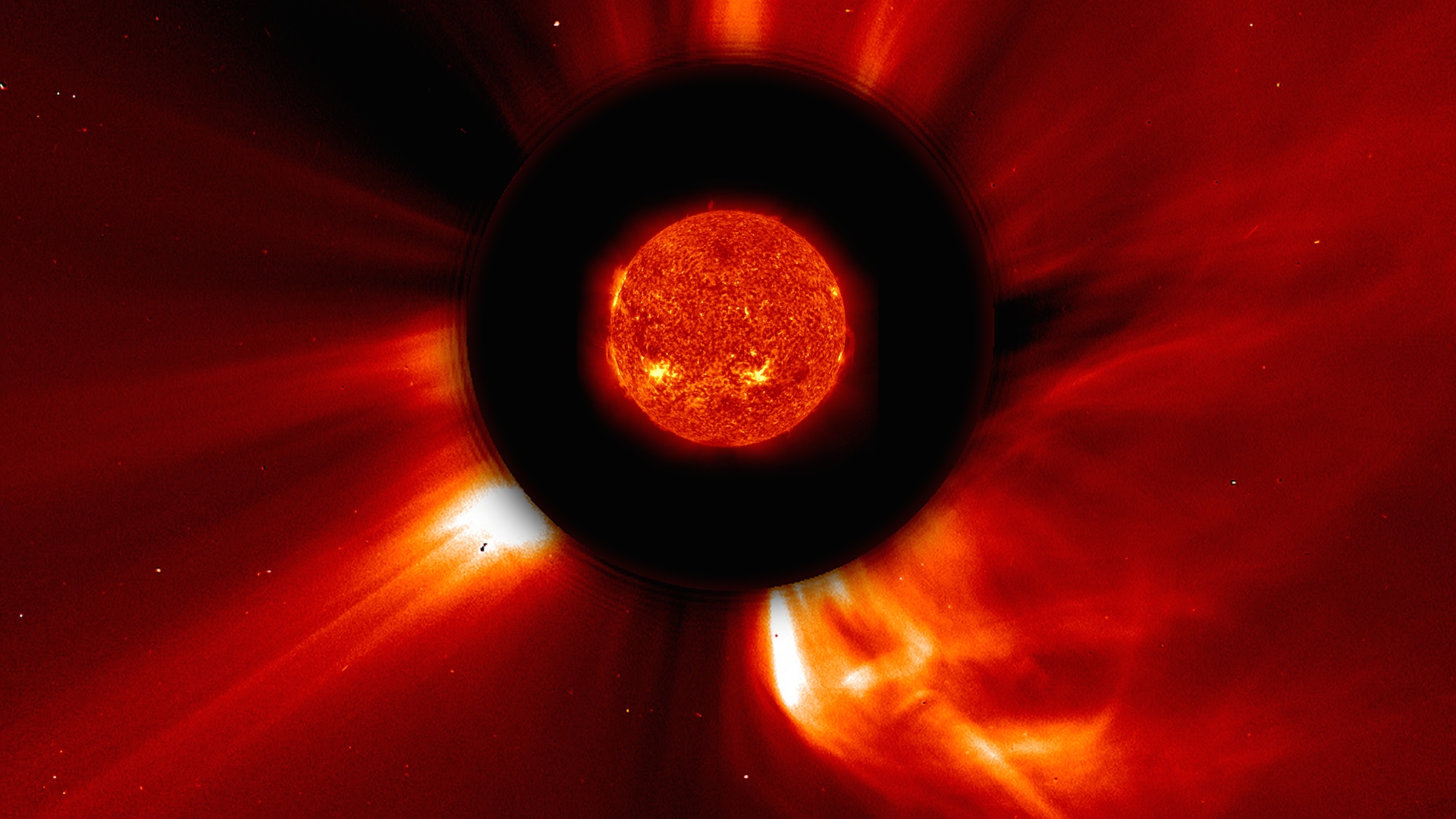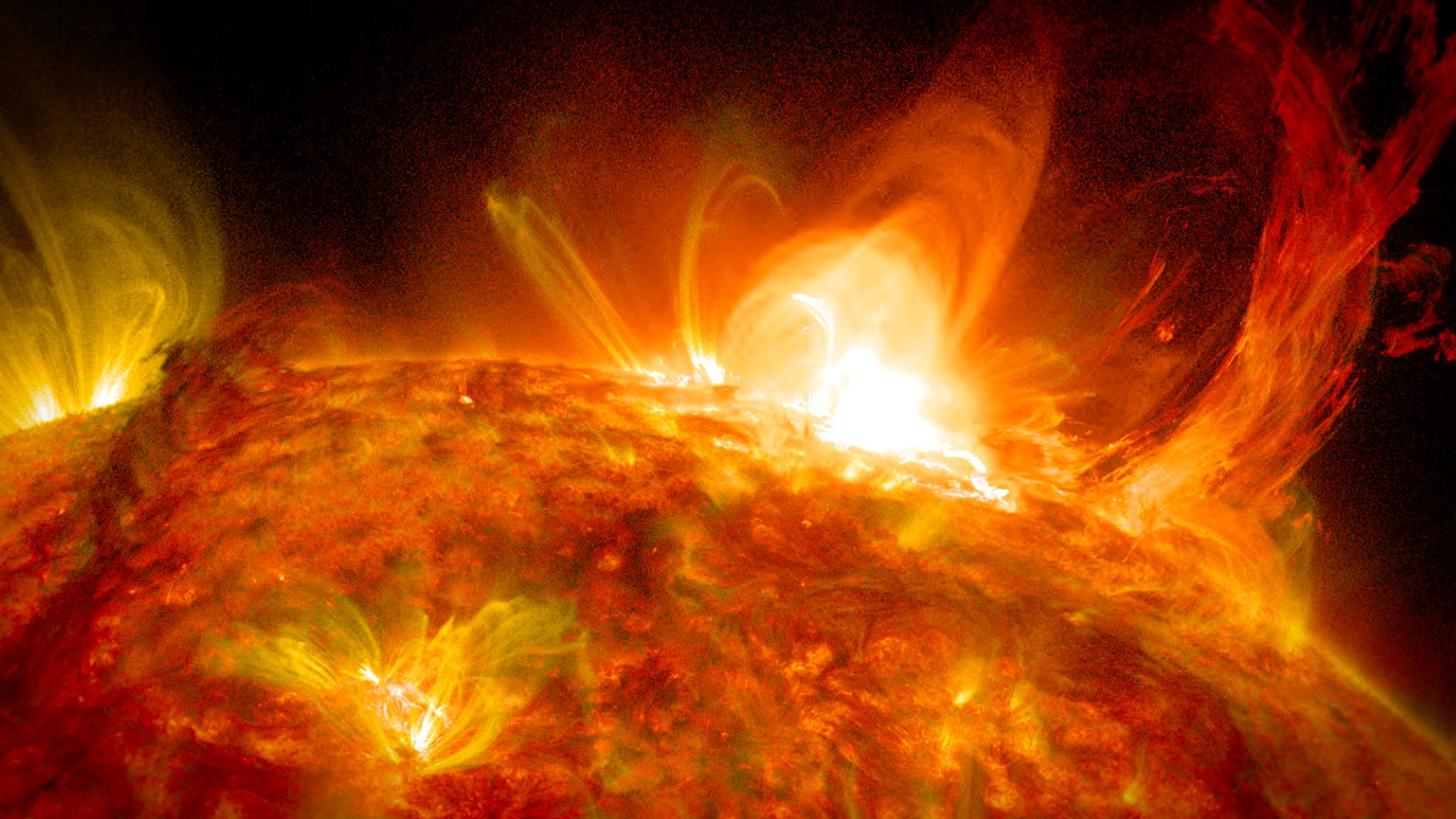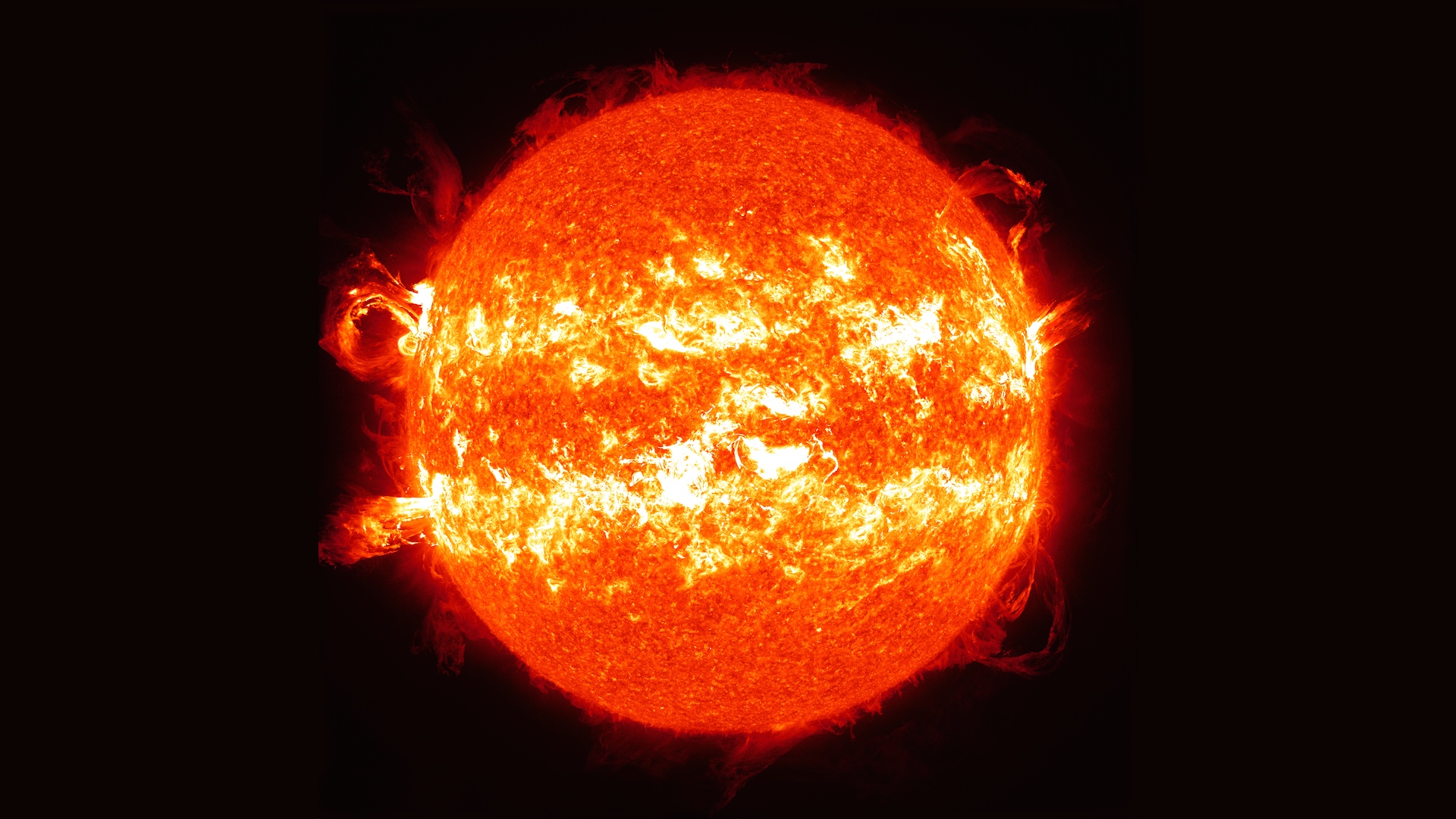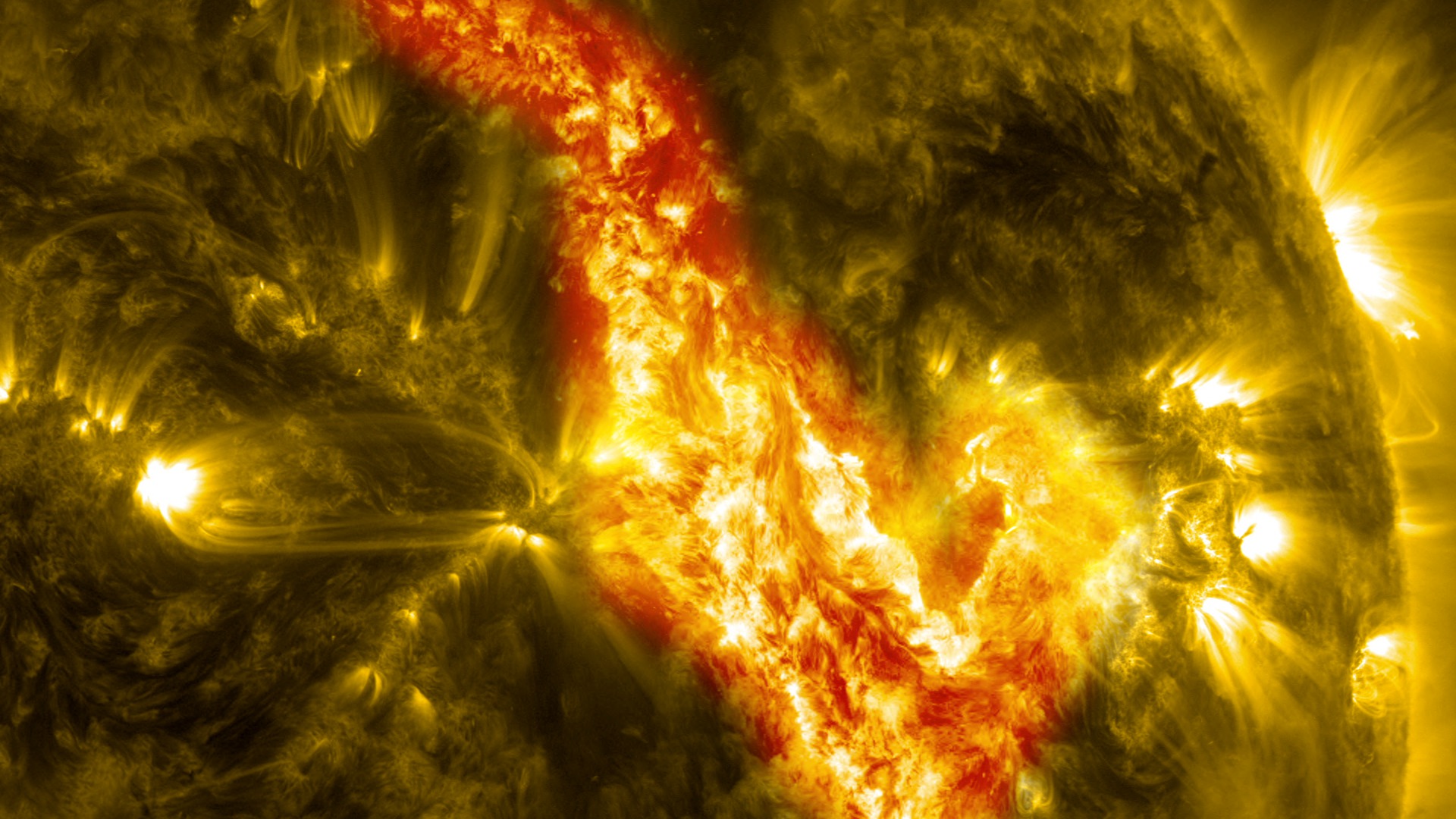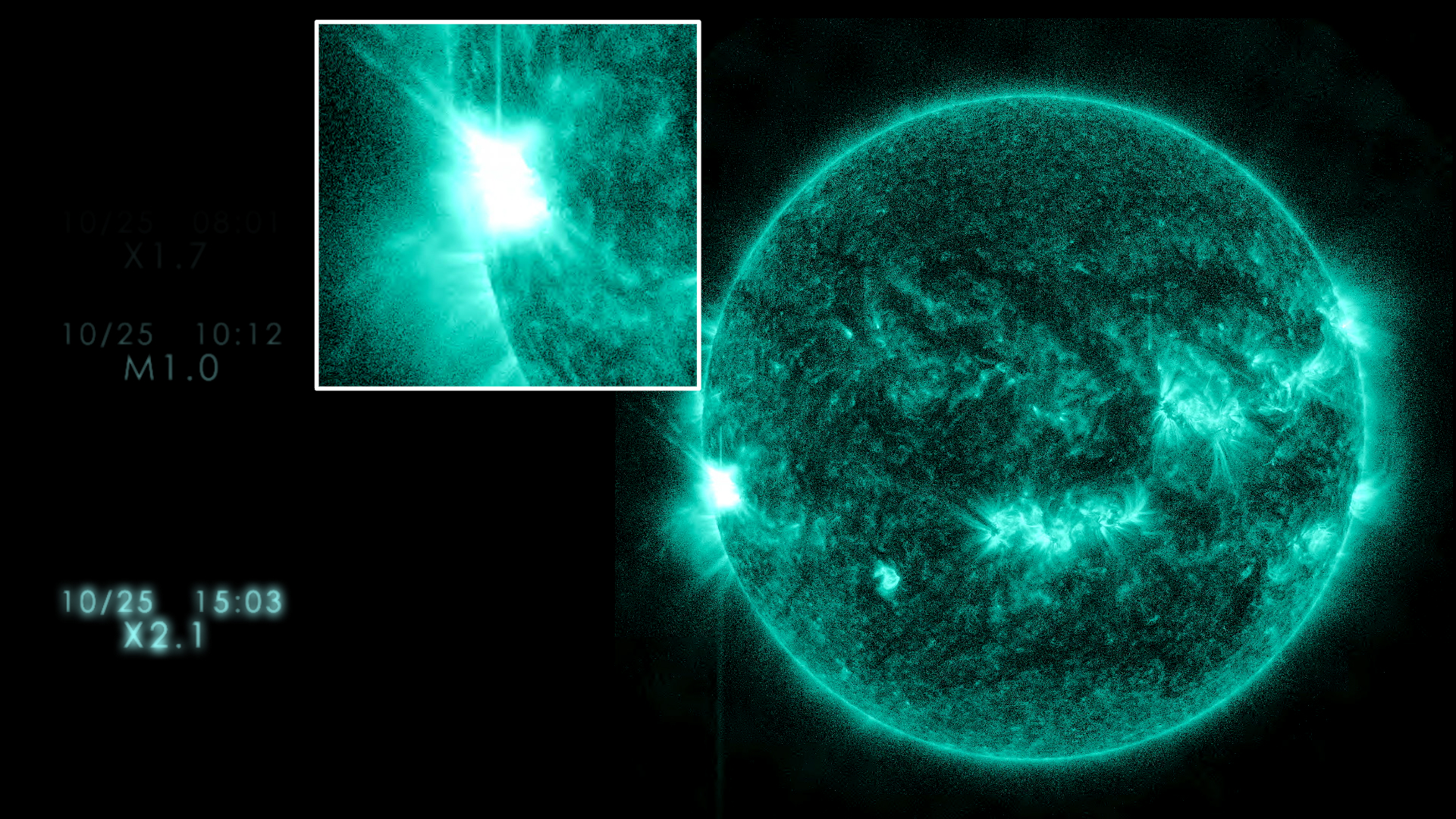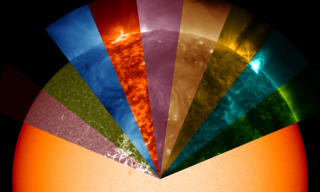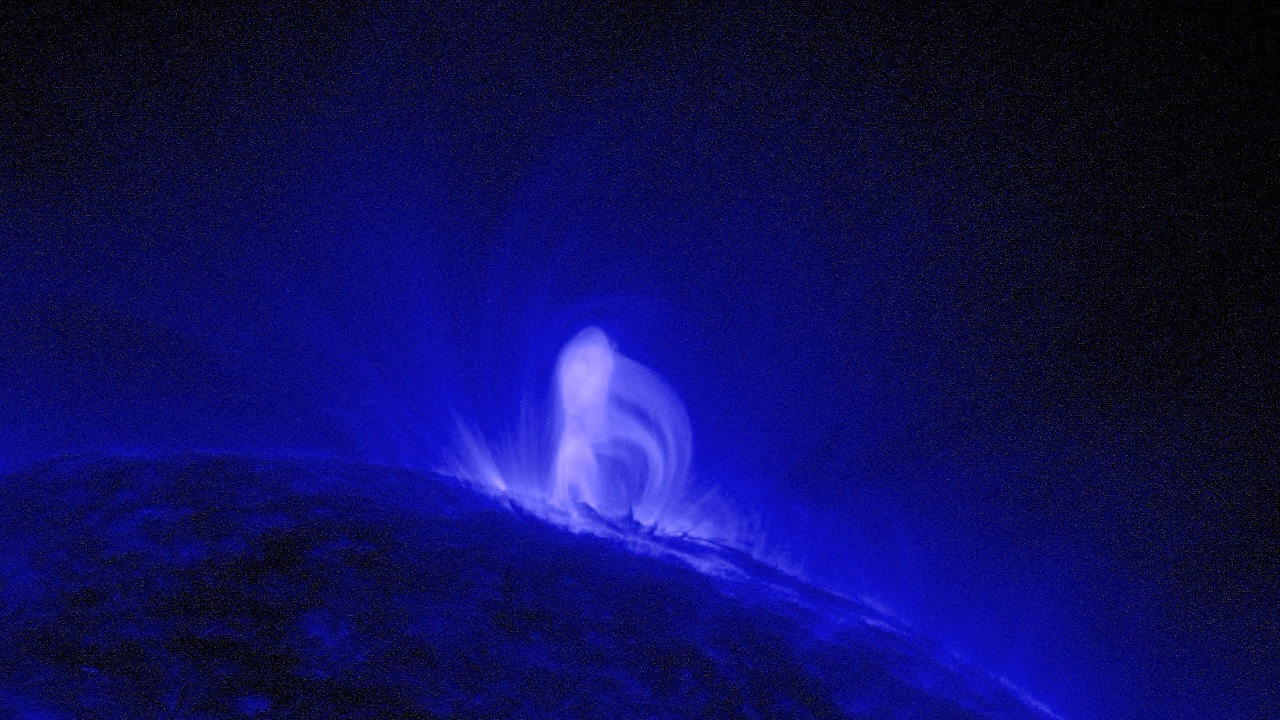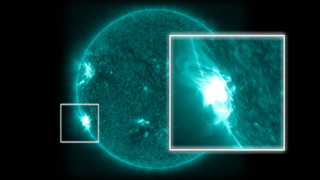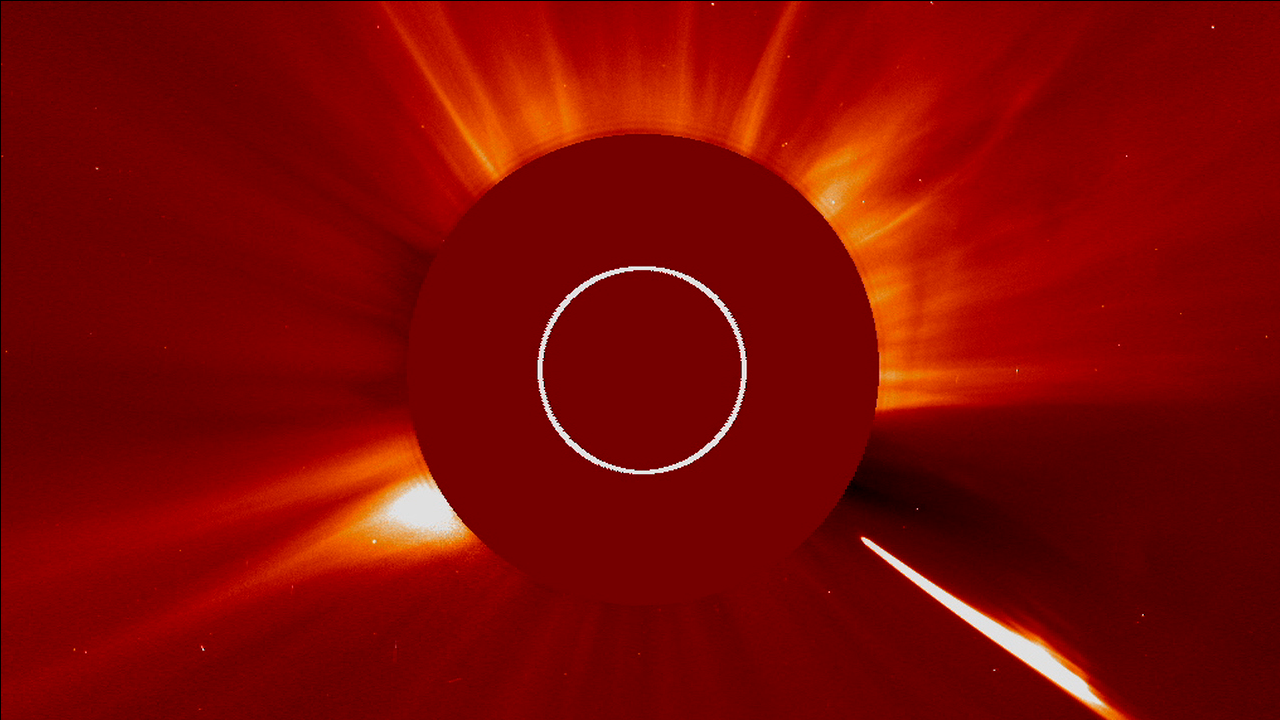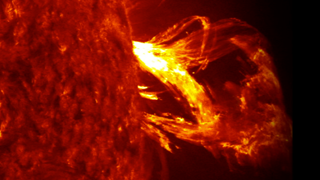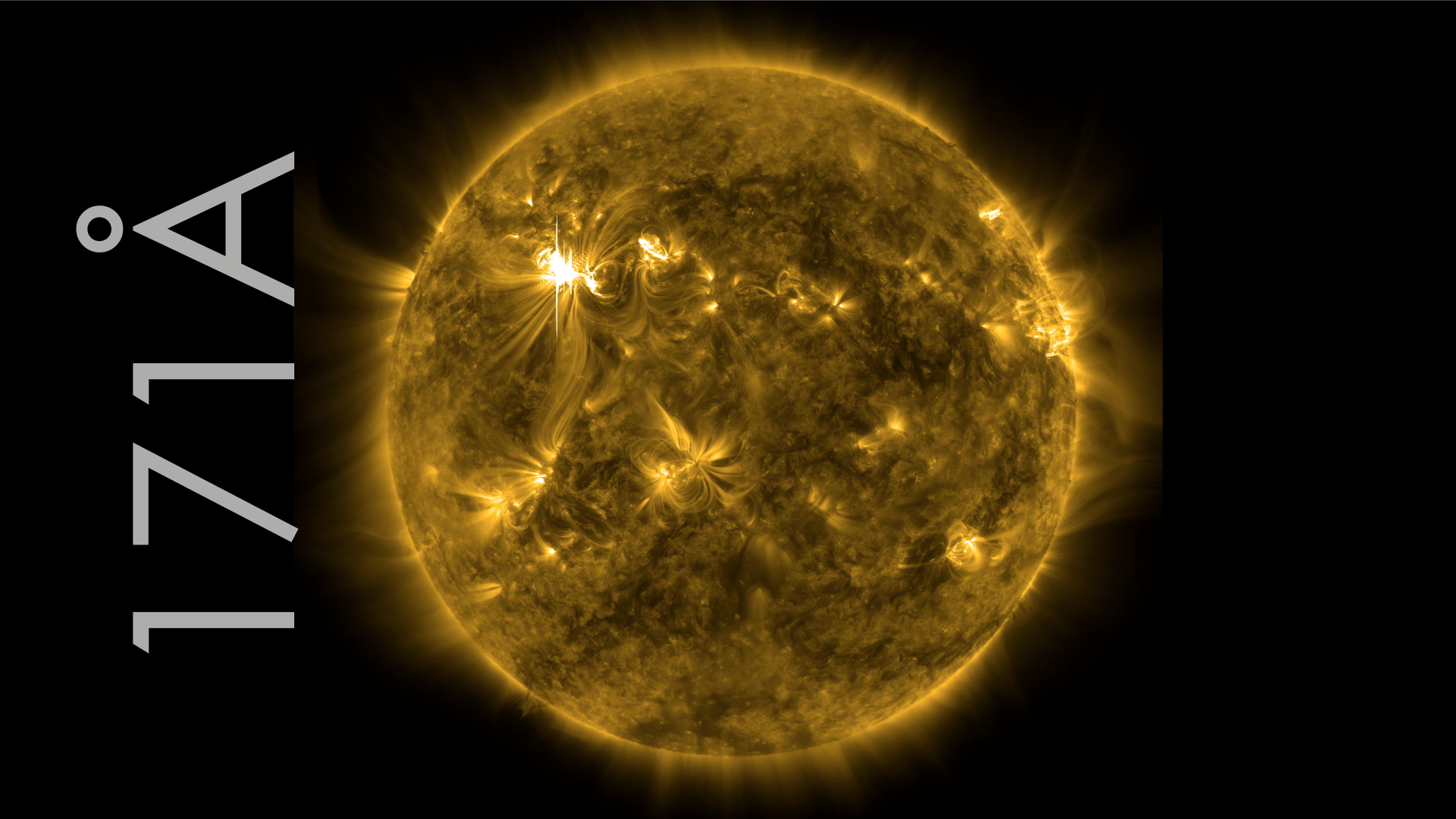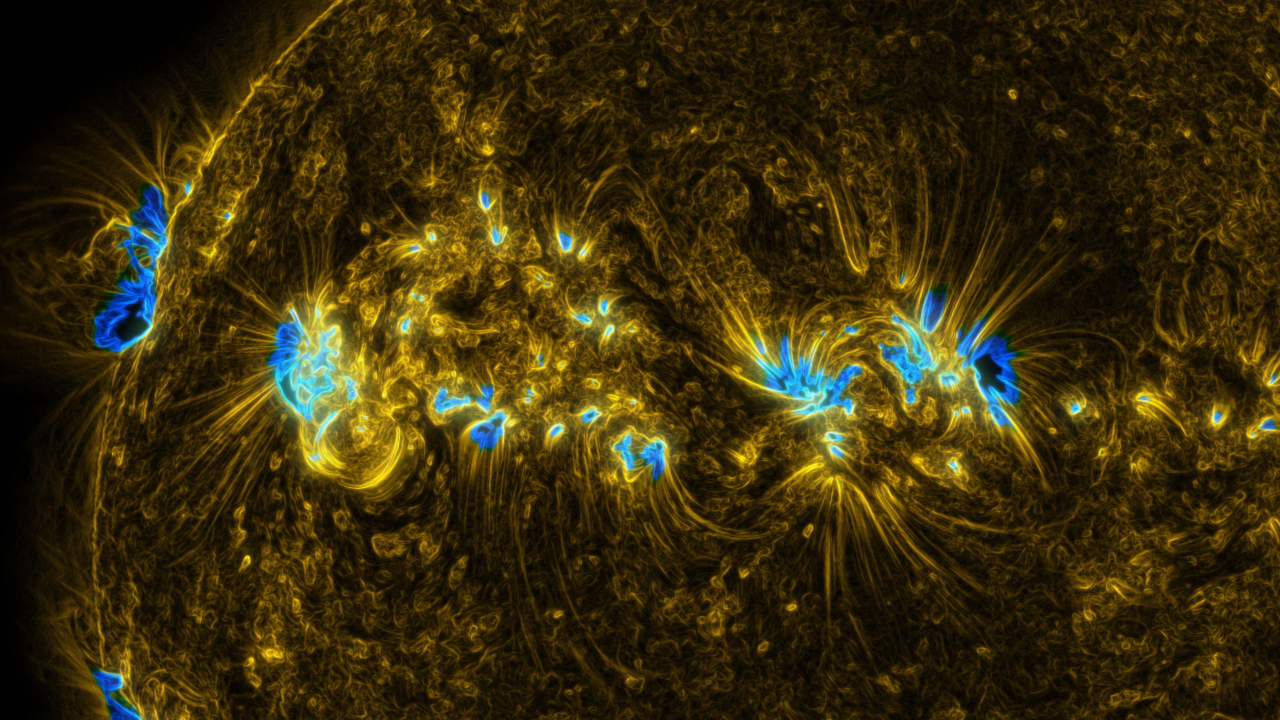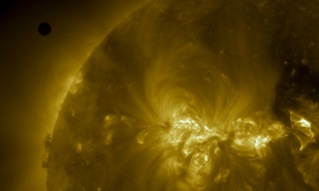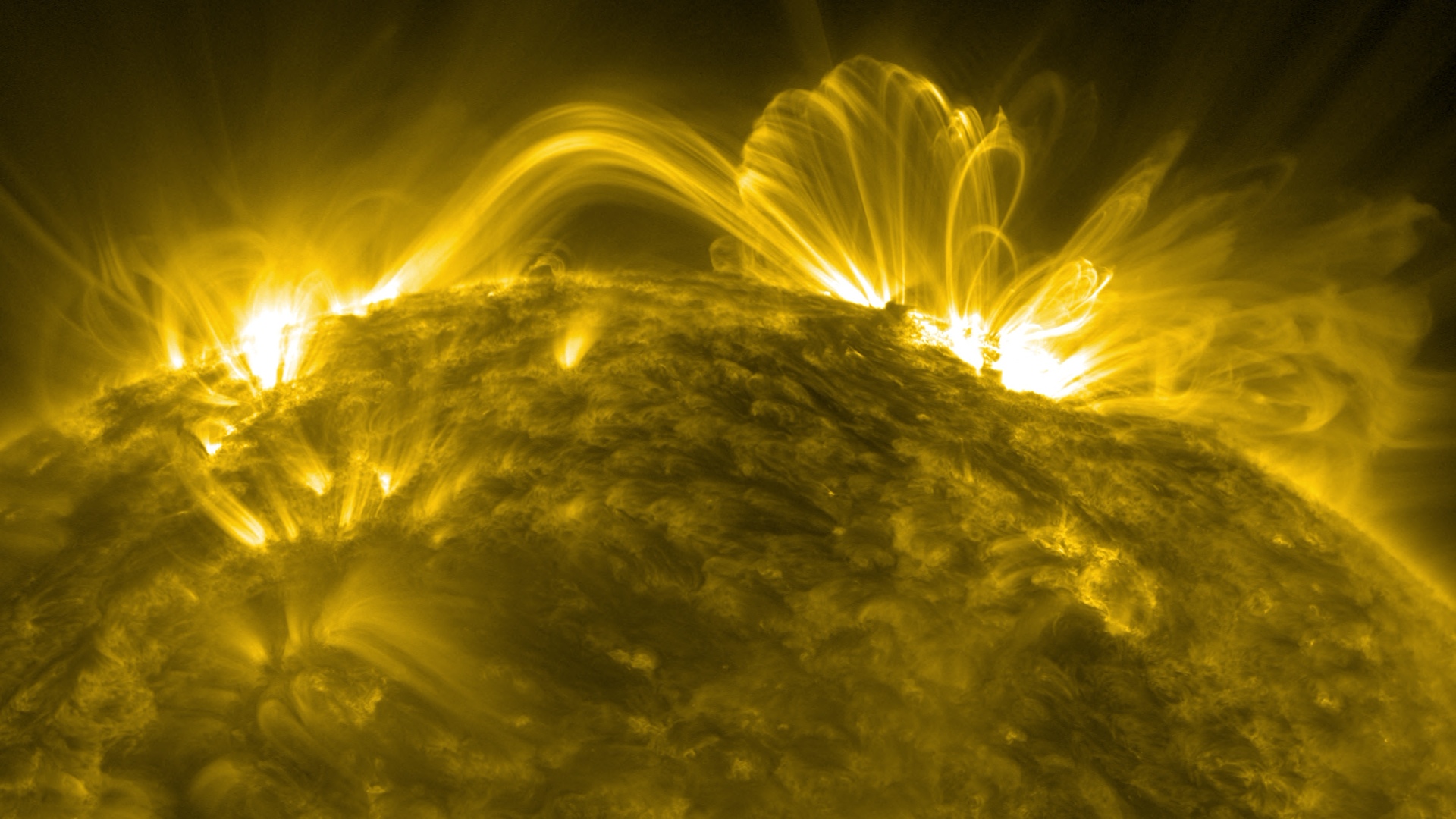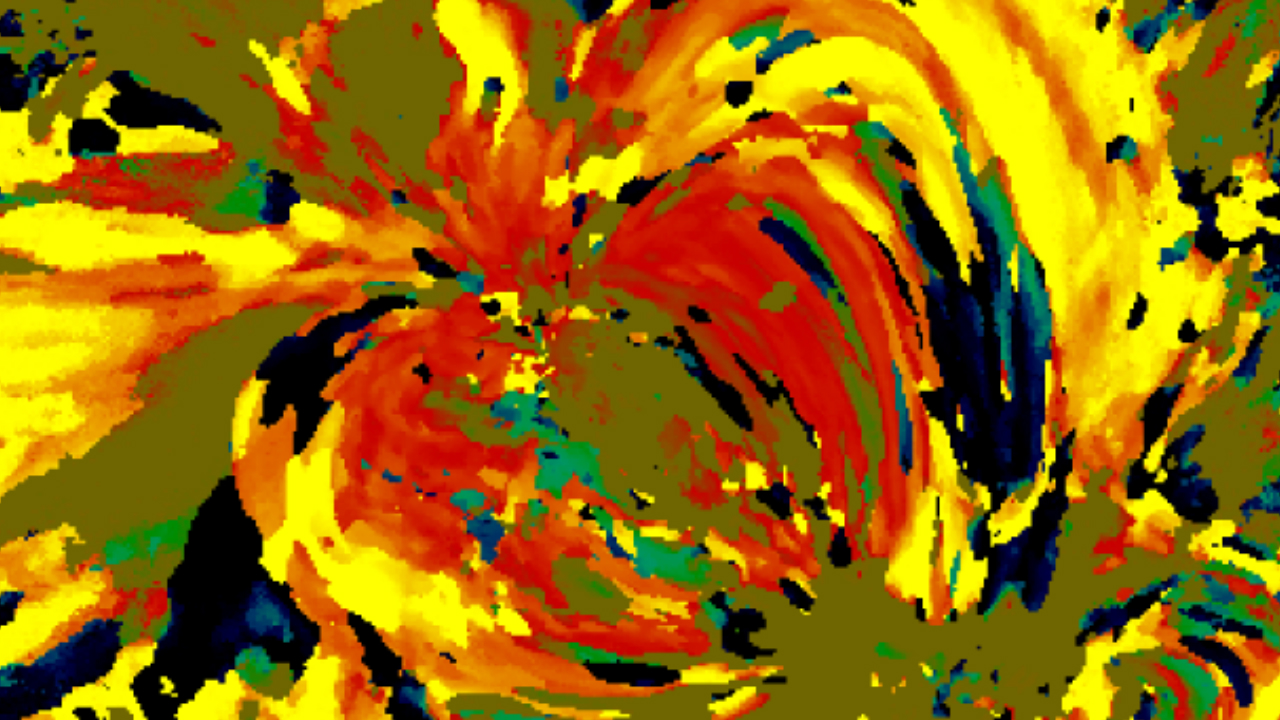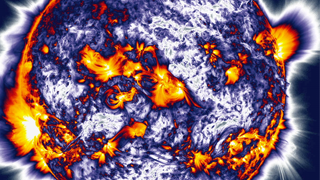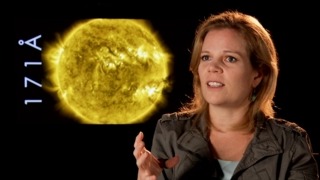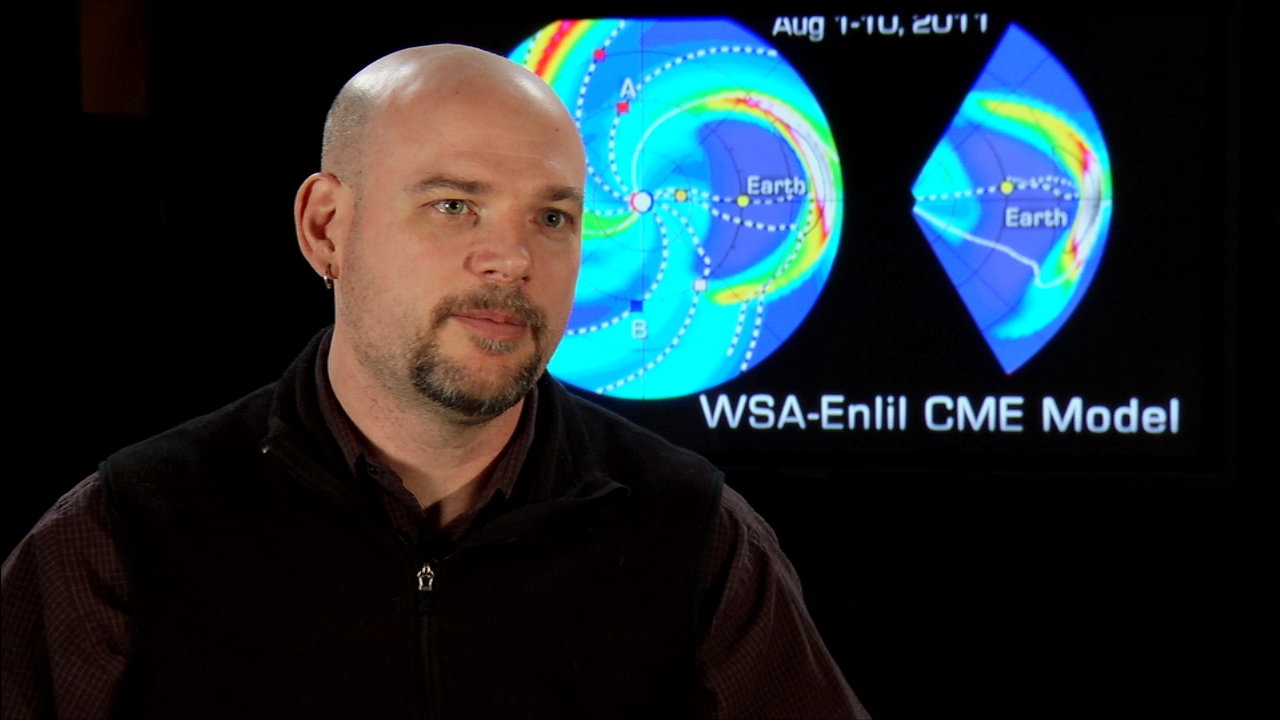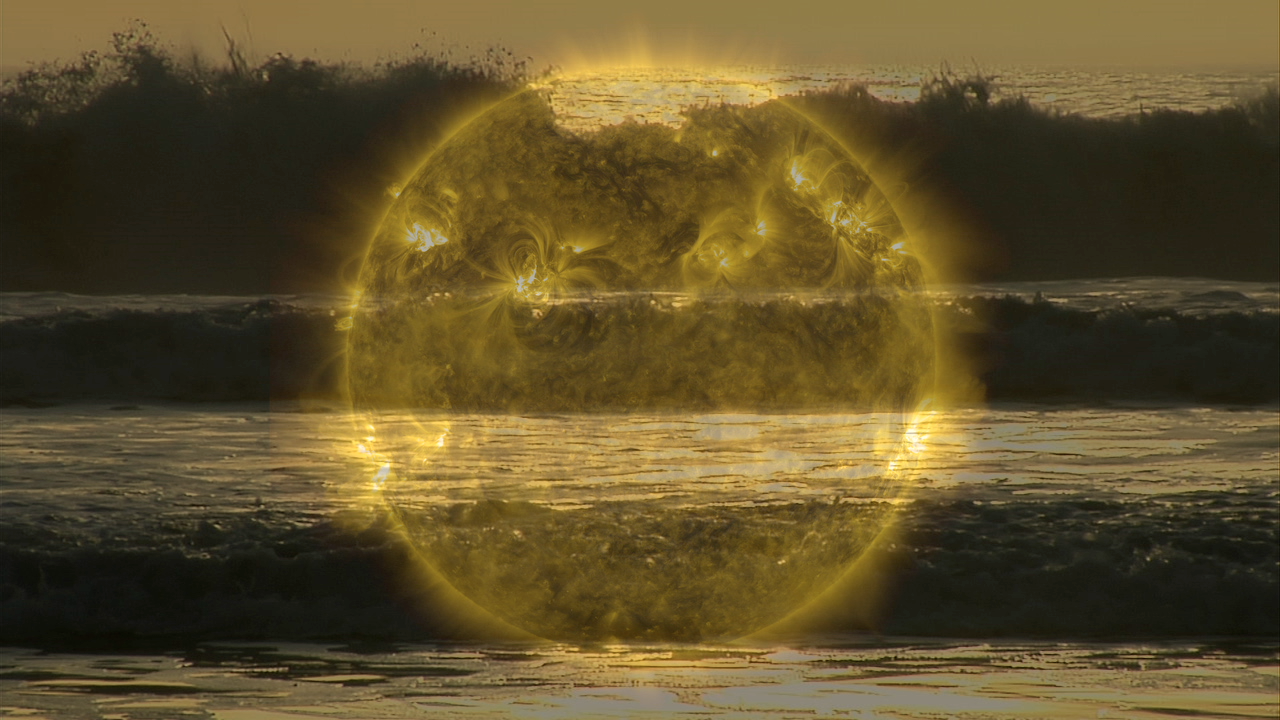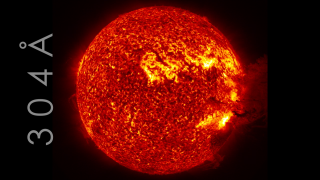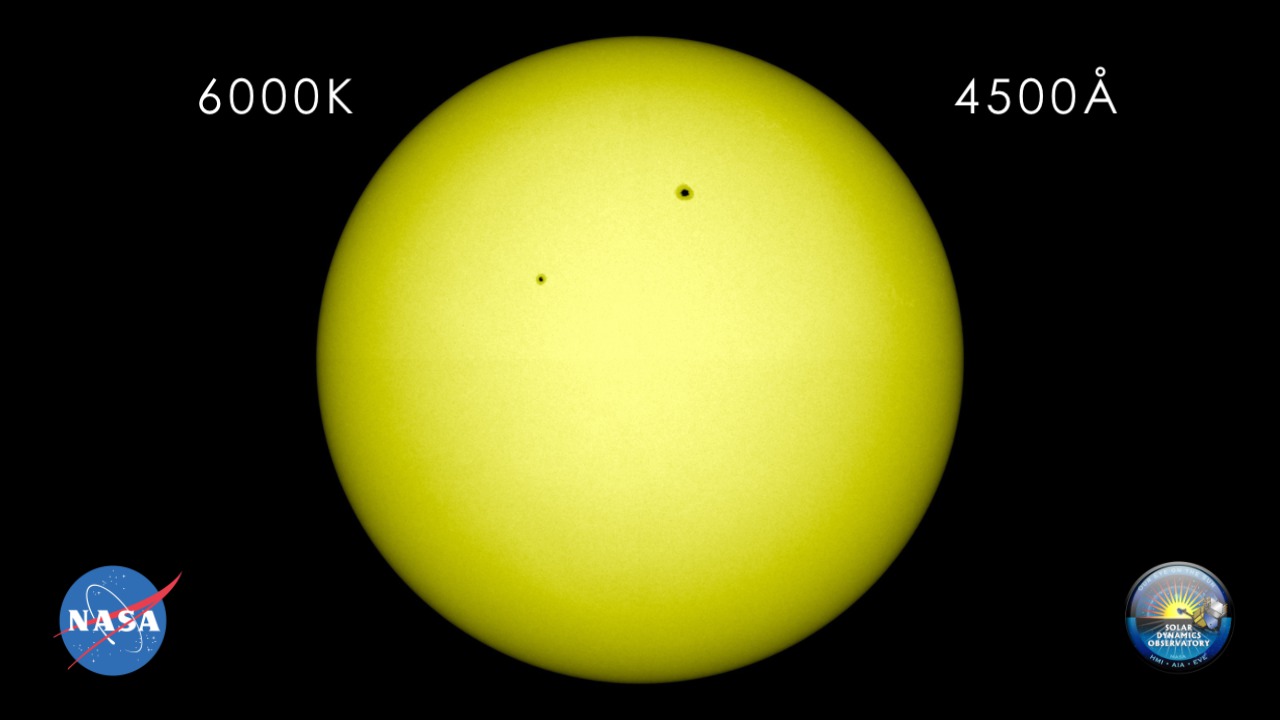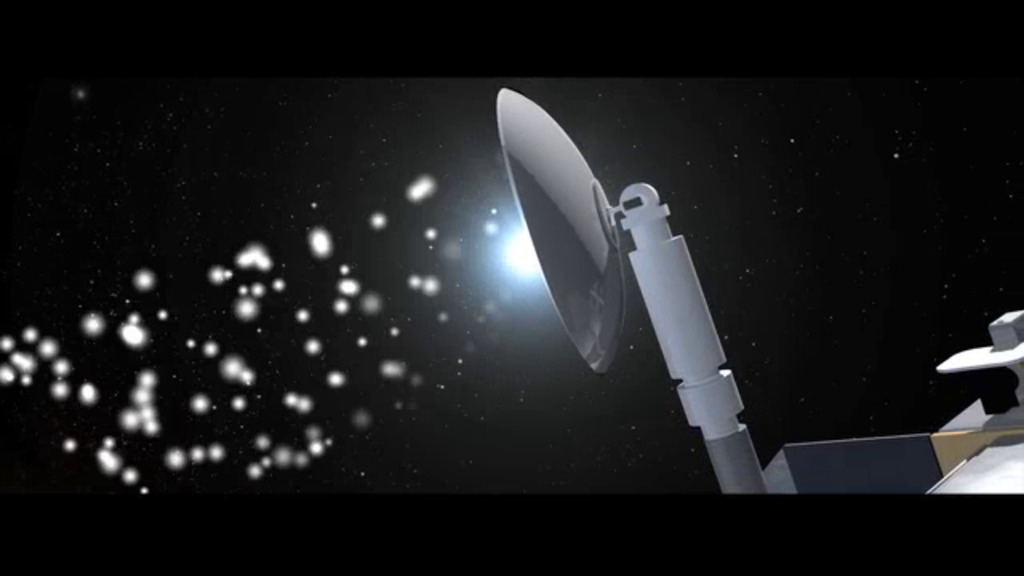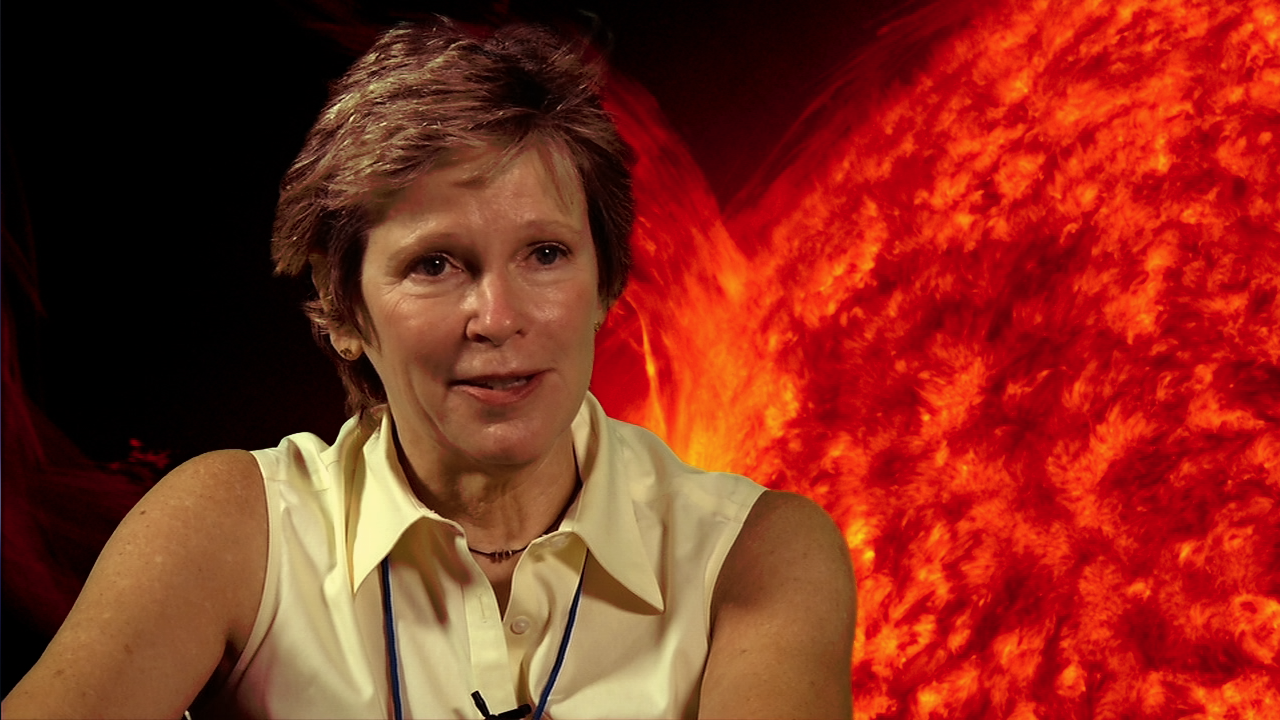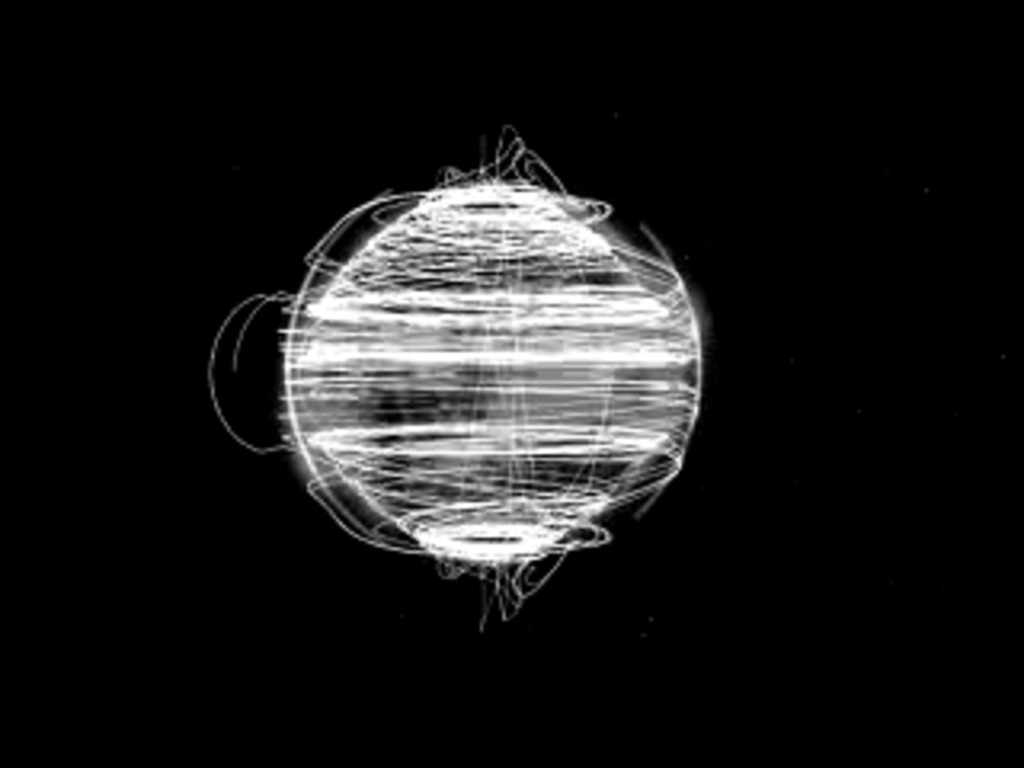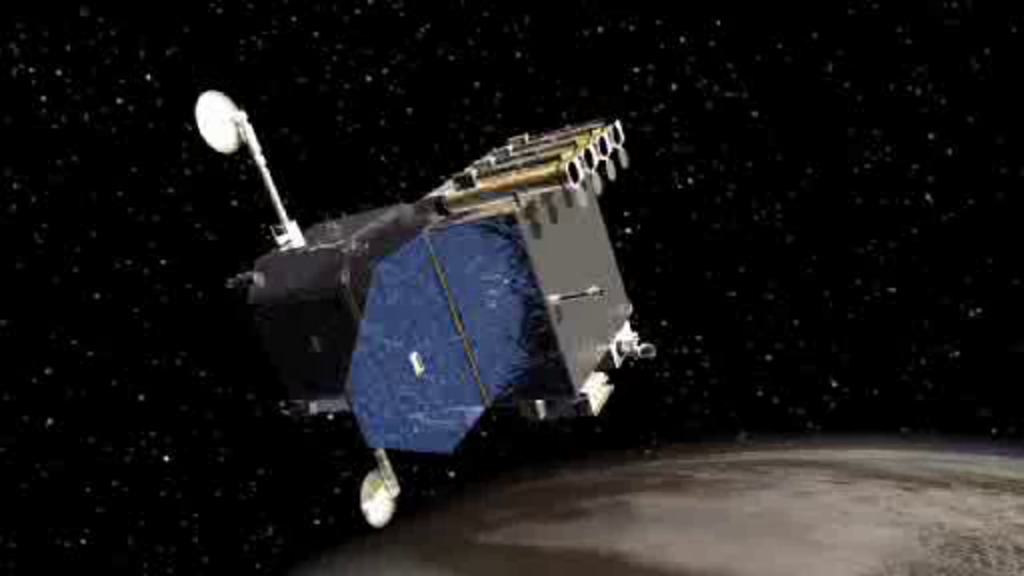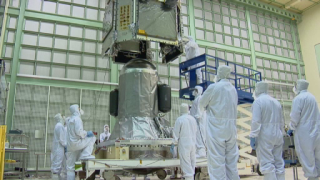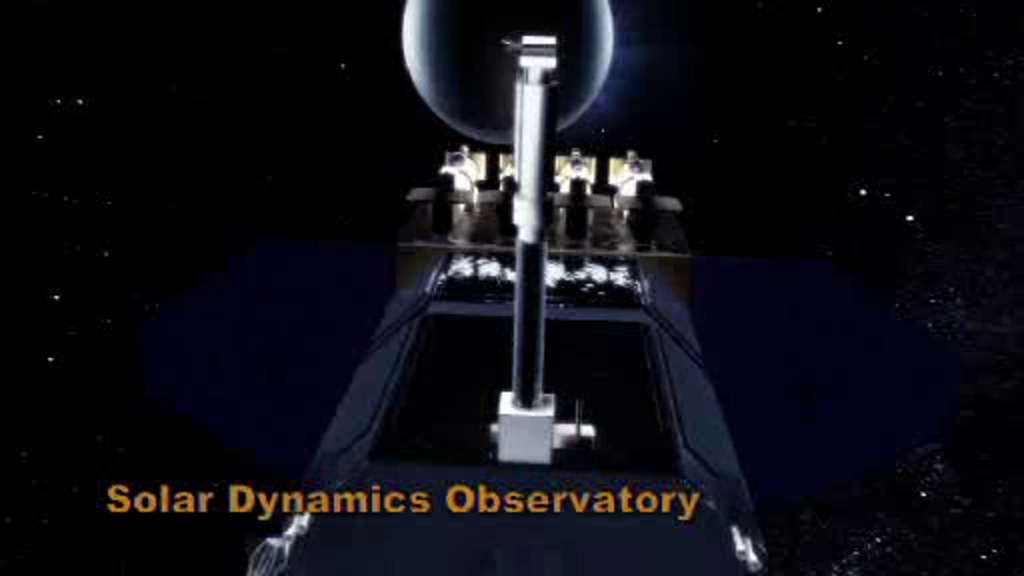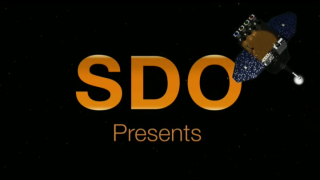SDO: Produced Videos
2024
Largest Flare yet from Solar Cycle 25
Go to this pageOn May 14, 2024, the Sun emitted a strong solar flare. This solar flare is the largest of Solar Cycle 25 and is classified as an X8.7 flare. X-class denotes the most intense flares, while the number provides more information about its strength.A solar flare is an intense burst of radiation, or light, on the Sun. Flares are our solar system’s most powerful explosive events. Light only takes about 8 minutes to travel from the Sun to Earth, so that’s how long it would take the energy from a flare to reach our planet. Stronger solar flares — those rated class M5 or above — can have impacts on technology that depends on Earth’s ionosphere (our electrically charged upper atmosphere), like high-frequency radio used for navigation and GPS.NASA’s Solar Dynamics Observatory (SDO) captured these images of the flare, which peaked at 12:51 p.m. ET on May 14. The X8.7 flare appears on the lower right edge of the Sun. (A small eruption appears afterward in the upper left.) SDO sees the Sun in more than 10 distinct wavelengths of light, showing solar material at different temperatures. Different wavelengths are shown in this video to highlight different features of the flare.Music credit: “Ethereal Mirrorscape” from the album Reflections written and produced by Lars LeonhardWatch this video on the NASA Goddard YouTube channel.Complete transcript available. || X8pt7_flare_May_14_2024.00_00_40_22.Still001.jpg (3840x2160) [3.0 MB] || X8pt7_flare_May_14_2024.00_00_40_22.Still001_print.jpg (1024x576) [342.3 KB] || X8pt7_flare_May_14_2024.00_00_40_22.Still001_searchweb.png (320x180) [75.1 KB] || X8pt7_flare_May_14_2024.00_00_40_22.Still001_web.png (320x180) [75.1 KB] || X8pt7_flare_May_14_2024.00_00_40_22.Still001_thm.png (80x40) [6.1 KB] || 14592_SDO_X8pt7_flare_May_14_2024_ProRes_Outro.webm (3840x2160) [20.4 MB] || 14592_SDO_X8pt7_flare_May_14_2024_Good_Outro.mp4 (3840x2160) [175.9 MB] || 14592_SDO_X8pt7_flare_May_14_2024_YouTube_Outro.mp4 (3840x2160) [673.0 MB] || 14592_SDO_X8pt7_flare_May_14_2024_ProRes_Outro.mov (3840x2160) [4.2 GB] ||
May 2-10, 2024 : A Busy Week of Flares
Go to this pageProduced VideoWatch this video on the NASA Goddard YouTube channel.Music Credit: “Halos” from the album Burning Clouds. Written and produced by Lars Leonhard. https://ultimae.bandcamp.com/track/halos || 14588_FlareRecap_thumbnail.jpg (1280x720) [205.8 KB] || 14588_FlareRecap_X.mp4 (1920x1080) [138.1 MB] || 14588_FlareRecap_YT.mp4 (1920x1080) [337.5 MB] || 14588FlareRecapCaptions.en_US.srt [1.5 KB] || 14588FlareRecapCaptions.en_US.vtt [1.4 KB] || 14588_FlareRecap_ProRes.mov (1920x1080) [3.2 GB] ||
NASA's SDO Captures a February Solar Flare Triple Play
Go to this pageThe Solar Dynamics Observatory (SDO) spotted three X-class flares on the Sun between February 21 and 22, 2024. Watch this video to see what those events looked like in several wavelengths of extreme ultraviolet light that SDO captures. The video opens with quick shots of the three flares in different wavelength blends. The first is a blend of 131 and 171-angstrom-light imagery, the second is 171 and 304, and the last is 171 and 1600. Each wavelength highlights different temperature plasma and reveals different layers and features of the Sun. 131 angstrom light shows both the extremely hot plasma of flares (6-10 million Kelvin) and cooler plasma (400,000 Kelvin). Credit: NASA's Goddard Space Flight Center/SDOMusic: "Serene Reverie" from the album Reflections. Written and produced by Lars Leonhard.Watch this video on the NASA Goddard YouTube channel.Complete transcript available. || February_Triple_Play_Still_print.jpg (1024x576) [166.0 KB] || February_Triple_Play_Still.jpg (3840x2160) [2.1 MB] || February_Triple_Play_Still_searchweb.png (320x180) [100.7 KB] || February_Triple_Play_Still_thm.png (80x40) [8.0 KB] || 14536_FebruaryXFlareTriplePlay_1080.webm (1920x1080) [26.0 MB] || Flare_Triple_Play_Captions.en_US.srt [811 bytes] || Flare_Triple_Play_Captions.en_US.vtt [772 bytes] || 14536_FebruaryXFlareTriplePlay_1080.mp4 (1920x1080) [405.7 MB] || 14536_FebruaryXFlareTriplePlay_1080_small.mp4 (1920x1080) [166.7 MB] || 14536_FebruaryXFlareTriplePlay_ProRes_3840x2160.mov (3840x2160) [14.2 GB] || 14536_FebruaryXFlareTriplePlay_4k_25mbps.mp4 (3840x2160) [670.9 MB] || 14536_FebruaryXFlareTriplePlay_4k_50mbps.mp4 (3840x2160) [1.3 GB] ||
2023
133 Days on the Sun
Go to this pageThis 133-day time lapse of the Sun at 17.1nm shows brilliant active regions, dynamic loops of plasma and numerous solar eruptions.Music (in order): Concave Hexagon, Heptagon, Tetrahedron, Triangular Prism, Square-based Pyramid, Irregular Quadrilateral, Equilateral Triangle, Dodecahedron, Icosahedron, all from "Geometric Shapes" written and produced by Lars Leonhard.Credit: NASA's Goddard Space Flight Center/SDOWatch this video on the NASA Goddard YouTube channel.Complete transcript available.Video Descriptive Text available. || 133DaysontheSun_StillSept15_print.jpg (1024x576) [134.4 KB] || 133DaysontheSun_StillSept15.png (3840x2160) [25.3 MB] || 133DaysontheSun_StillSept15.jpg (3840x2160) [1.1 MB] || 133DaysontheSun_StillSept15_searchweb.png (320x180) [74.6 KB] || 133DaysontheSun_StillSept15_thm.png (80x40) [6.8 KB] || 14263_133_Days_on_the_Sun_1080.mp4 (1920x1080) [4.3 GB] || 14263_133_Days_on_the_Sun_1080.webm (1920x1080) [470.3 MB] || 14263_133_Days_on_the_Sun_ProRes_3840x2160_2997.mov (3840x2160) [156.8 GB] || 14263_133_Days_on_the_Sun_4k_100mbps.mp4 (3840x2160) [41.5 GB] || 14263_133_Days_on_the_Sun_4k.mp4 (3840x2160) [10.5 GB] || 133_Days-on_the_Sun_SRT_Captions.en_US.srt [2.5 KB] || 133_Days-on_the_Sun_SRT_Captions.en_US.vtt [2.6 KB] ||
2022
A Week Filled with Flares, August 2022
Go to this pageThe Solar Dynamics Observatory (SDO) spotted 11 significant flares on the Sun from August 12-18, 2022. Here's what that looked like at 171 angstroms, one of the wavelengths of light that SDO captures.Credit: NASA's Goddard Space Flight Center/SDOMusic: "Rhombus" from Geometric Shapes. Written and produced by Lars Leonhard.Watch this video on the NASA Goddard YouTube channel.Complete transcript available. || Flare_Week_Still_1_print.jpg (1024x576) [359.4 KB] || Flare_Week_Still_1.jpg (3840x2160) [2.6 MB] || Flare_Week_Still_1_searchweb.png (320x180) [77.4 KB] || Flare_Week_Still_1_thm.png (80x40) [6.3 KB] || 14202_Flare_Week_August2022_1080.mp4 (1920x1080) [359.6 MB] || 14202_Flare_Week_August2022_1080.webm (1920x1080) [25.0 MB] || 14202_Flare_Week_August2022_ProRes_3840x2160_2997.mov (3840x2160) [12.1 GB] || 14202_Flare_Week_August2022_4k_best.mp4 (3840x2160) [1.1 GB] || 14202_Flare_Week_August2022_4k.mp4 (3840x2160) [453.5 MB] || 14202_Flare_Week_SRT_Captions.en_US.srt [2.2 KB] || 14202_Flare_Week_SRT_Captions.en_US.vtt [2.2 KB] ||
Concert videos
Go to this pageThese videos are designed to accompany live orchestral performances. For more information and inquiries about their use, please contact Scott Wiessinger at scott.wiessinger@nasa.gov. ||
Sun Emits X1.5 Flare on May 10, 2022
Go to this pageShort video of the X1.5 flare emitted by the Sun on May 10, 2022 and captured by the Solar Dynamics Observatory in three wavelengths of extreme ultraviolet light that highlight different temperatures and features of the Sun's atmosphere, the corona.Credit: NASA/GSFC/SDOMusic: "Examples" from Universal Production MusicComplete transcript available. || May102022_X1pt5Flare_171-131-304.jpg (1920x1080) [979.2 KB] || May102022_X1pt5Flare_171-131-304_searchweb.png (320x180) [55.6 KB] || May102022_X1pt5Flare_171-131-304_thm.png (80x40) [4.4 KB] || 14160_May102022_X1pt5_Flare_ProRes_1920x1080_2997.mov (1920x1080) [829.3 MB] || 14160_May102022_X1pt5_Flare_Best_1080.mp4 (1920x1080) [138.6 MB] || 14160_May102022_X1pt5_Flare_1080.mp4 (1920x1080) [57.0 MB] || 14160_May102022_X1pt5_Flare_ProRes_1920x1080_2997.webm (1920x1080) [5.6 MB] || 14160_May102022_X1pt5_Flare_SRT_Captions.en_US.srt [547 bytes] || 14160_May102022_X1pt5_Flare_SRT_Captions.en_US.vtt [560 bytes] ||
2021
Active October Sun Emits X-class Flare
Go to this pageBrighter than a shimmering ghost, faster than the flick of a black cat’s tail, the Sun cast a spell in our direction, just in time for Halloween. This imagery captured by NASA’s Solar Dynamics Observatory covers a busy few days of activity between Oct. 25-28 that ended with a significant solar flare. From late afternoon Oct. 25 through mid-morning Oct. 26, an active region on the left limb of the Sun flickered with a series of small flares and petal-like eruptions of solar material. Meanwhile, the Sun was sporting more active regions at its lower center, directly facing Earth. On Oct. 28, the biggest of these released a significant flare, which peaked at 11:35 a.m. EDT. Credit: NASA/GSFC/SDOMusic: "Immersion" from Above and Below. Written and produced by Lars LeonhardWatch this video on the NASA Goddard YouTube channel.Complete transcript available. || ActiveOctober_Still.jpg (1920x1080) [956.2 KB] || 13982_ActiveOctober_ProRes_1920x1080_2997.mov (1920x1080) [2.4 GB] || 13982_ActiveOctober_1080_Best.mp4 (1920x1080) [436.2 MB] || 13982_ActiveOctober_1080.mp4 (1920x1080) [188.1 MB] || 13982_ActiveOctober_1080_Best.webm (1920x1080) [19.7 MB] || 13982_ActiveOctober_SRT_Captions.en_US.srt [574 bytes] || 13982_ActiveOctober_SRT_Captions.en_US.vtt [587 bytes] ||
Why Does NASA Observe The Sun in Different Colors?
Go to this pageThe Solar Dynamics Observatory, or SDO, was launched on Feb. 11, 2010, and began collecting science data a few months later. With two imaging instruments – the Atmospheric Imaging Assembly and the Helioseismic and Magnetic Imager, which were designed in concert to provide complementary views of the Sun – SDO sees the Sun in more than 10 distinct wavelengths of light, showing solar material at different temperatures. SDO also measures the Sun’s magnetic field and the motion of solar material at its surface, and, using a technique called helioseismology, allows scientists to probe deep into the Sun's interior, where the Sun’s complex magnetic fields sprout from. And with more than a decade of observation under its belt, SDO has provided scientists with hundreds of millions of images of our star. ||
See the Sun like never before! Science of the Sun Shines Bright With New Stamps Showcasing Stunning Images From NASA’s Spacecraft Live Shots
Go to this pageFind out more about the Sun on social media @NASASun and online at www.nasa.gov/sunearrthQuick link to associated B-R0LLQuick link to canned interview with DR. ALEX YOUNGQuick link to canned interview in Spanish with YAIRESKA COLLADO-VEGA || sdo_banner.jpg (1480x594) [580.7 KB] || sdo_banner_print.jpg (1024x410) [368.9 KB] || sdo_banner_searchweb.png (320x180) [112.7 KB] || sdo_banner_thm.png (80x40) [25.4 KB] ||
Animation of USPS Stamps Featuring NASA's Solar Dynamic Observatory
Go to this pageThe U.S. Postal Service illuminates the light and warmth of our nearest star by highlighting these stunning images of the Sun on stamps. These images come from NASA’s Solar Dynamics Observatory, a spacecraft launched in February 2010 to keep a constant watch on the Sun.The Sun is the only star that humans are able to observe in great detail, making it a vital source of information about the universe. The Solar Dynamics Observatory lets us see the Sun in wavelengths of ultraviolet light that would otherwise be invisible to our eyes. Each black-and-white image is colorized to the bright hues seen here.The stamps highlight different features on the Sun that help scientists learn about how our star works and how its constantly churning magnetic fields create the solar activity we see. Sunspots, coronal holes and coronal loops, for example, can reveal how those magnetic fields dance through the Sun and its atmosphere. Observing plasma blasts and solar flares can help us better understand and mitigate the impact of such eruptions on technology in space.The Sun Science stamps are being issued as Forever stamps, which will always be equal in value to the current First-Class Mail 1-ounce price. ||
2020
Solar Activity Continues to Rise with 'Anemone' Eruption
Go to this pageShort video showing the solar flare and subsequent prominence eruption and "arcade" of loops.Credit: NASA/GSFC/SDOMusic: "Beautiful Awesome" from Universal Production MusicWatch this video on the NASA Goddard YouTube channel.Complete transcript available. || Anemone_Eruption_131-171_Blend.jpg (1920x1080) [281.9 KB] || Anemone_Eruption_131-171_Blend_searchweb.png (180x320) [78.6 KB] || Anemone_Eruption_131-171_Blend_thm.png (80x40) [6.6 KB] || 13778_Anemone_Eruption_ProRes_1920x1080_2997.mov (1920x1080) [2.0 GB] || 13778_Anemone_Eruption_Best_1080.mp4 (1920x1080) [718.2 MB] || 13778_Anemone_Eruption_1080.mp4 (1920x1080) [220.6 MB] || 13778_Anemone_Eruption_Best_1080.webm (1920x1080) [16.0 MB] || AnemoneEruption_SRT_Captions.en_US.srt [500 bytes] || AnemoneEruption_SRT_Captions.en_US.vtt [513 bytes] ||
The Solar Cycle As Seen From Space
Go to this pageVIDEO IN ENGLISH Watch this video on the NASA Goddard YouTube channel.The Sun is stirring from its latest slumber. As sunspots and flares, signs of a new solar cycle, bubble from the Sun’s surface, scientists are anticipating a flurry of solar activity over the next few years. Roughly every 11 years, at the height of this cycle, the Sun’s magnetic poles flip—on Earth, that’d be like the North and South Poles’ swapping places every decade—and the Sun transitions from sluggish to active and stormy. At its quietest, the Sun is at solar minimum; during solar maximum, the Sun blazes with bright flares and solar eruptions. In this video, view the Sun's disk from our space telescopes as it transitions from minimum to maximum in the solar cycle.Music credit: "Observance" by Andrew Michael Britton [PRS], David Stephen Goldsmith [PRS] from Universal Production Music || 13716_SolarCycleFromSpace_YouTube.01410_print.jpg (1024x576) [68.8 KB] || 13716_SolarCycleFromSpace_YouTube.01410_searchweb.png (320x180) [35.9 KB] || 13716_SolarCycleFromSpace_YouTube.01410_web.png (320x180) [35.9 KB] || 13716_SolarCycleFromSpace_YouTube.01410_thm.png (80x40) [3.8 KB] || 13716_SolarCycleFromSpace_Twitter.mp4 (1920x1080) [21.2 MB] || 13716_SolarCycleFromSpace_YouTube.webm (1920x1080) [11.0 MB] || SolarCycleAsSeenFromSpace.en_US.srt [630 bytes] || SolarCycleAsSeenFromSpace.en_US.vtt [641 bytes] || 13716_SolarCycleFromSpace_Facebook.mp4 (1920x1080) [115.2 MB] || 13716_SolarCycleFromSpace_Prores.mov (1920x1080) [1.3 GB] || 13716_SolarCycleFromSpace_YouTube.mp4 (1920x1080) [153.6 MB] ||
A Decade of Sun
Go to this pageThis 10-year time lapse of the Sun at 17.1nm shows the rise and fall of the solar cycle and notable events, like transiting planets and solar eruptions. Music: "Solar Observer" written and produced for this video by Lars Leonhard.Credit: NASA's Goddard Space Flight Center/SDOWatch this video on the NASA Goddard YouTube channel.Complete transcript available. || SDO_Year10_Poster_1080.png (1920x1080) [7.5 MB] || SDO_Year10_Poster_1080.jpg (1920x1080) [519.0 KB] || SDO_Year10_Poster_4k.jpg (3840x2160) [972.4 KB] || SDO_Year10_Poster_4k.png (3840x2160) [27.2 MB] || SDO_10_Year_Sun_1080_15mbps.mp4 (1920x1080) [6.5 GB] || SDO_Year_10_FINAL_720FB.mp4 (1280x720) [7.3 GB] || SDO_10_Year_Sun_1080_15mbps.webm (1920x1080) [482.2 MB] || SDO_10_Year_Sun_ProRes_3840x2160_24.mov (3840x2160) [191.6 GB] || SDO_10_Year_Sun_4k_100mbps.mp4 (3840x2160) [42.9 GB] || SDO_10_Year_Sun_4k_20mbps.mp4 (3840x2160) [8.7 GB] || SDO_10_Year_Sun_SRT_Captions.en_US.srt [2.7 KB] || SDO_10_Year_Sun_SRT_Captions.en_US.vtt [2.8 KB] ||
SDO Celebrates its Tenth Launch Anniversary
Go to this pageCapturing an image in ten different wavelengths of light every 12 seconds, NASA’s Solar Dynamics Observatory — SDO — has provided an unprecedentedly clear picture of how massive explosions on the Sun grow and erupt ever since its launch on Feb. 11, 2010. The imagery is also captivating, allowing one to watch the constant ballet of solar material through the Sun's atmosphere, the corona. This year marks the tenth anniversary of SDO's launch and the start of its decade watching the Sun.Music: "Encompass" from Universal Production MusicWatch this video on the NASA Goddard YouTube channel.Complete transcript available. || PROMO_FINAL.00_01_04_08.Still001.jpg (1920x1080) [489.9 KB] || PROMO_FINAL.00_01_04_08.Still001_searchweb.png (320x180) [80.6 KB] || PROMO_FINAL.00_01_04_08.Still001_thm.png (80x40) [6.0 KB] || SDO_10th_Promo_ProRes_1920x1080_2997.mov (1920x1080) [981.6 MB] || SDO_10th_Promo_Best_1080.mp4 (1920x1080) [363.3 MB] || SDO_10th_Promo_Good_1080.mp4 (1920x1080) [141.7 MB] || SDO_10th_Promo_Best_1080.webm (1920x1080) [10.2 MB] || SDO_10th_Promo_SRT_Captions.en_US.srt [820 bytes] || SDO_10th_Promo_SRT_Captions.en_US.vtt [833 bytes] ||
2019
A New Kind of Explosion on the Sun
Go to this pageComplete transcript available.Watch this video on the NASA Goddard YouTube channel.Music Credit: Light Hearted Angst by Dewey Dellay || ReconnThumb.jpg (1920x1080) [156.1 KB] || ReconnThumb_searchweb.png (320x180) [100.6 KB] || ReconnThumb_thm.png (80x40) [7.3 KB] || ForcedReconnV2_Twitter.mp4 (1920x1080) [29.6 MB] || ForcedReconnV2.webm (1920x1080) [14.8 MB] || ForcedReconnV2.mp4 (1920x1080) [134.9 MB] || ForcedReconnV2_FB.mp4 (1920x1080) [155.5 MB] || ForcedReconnV2_YouTube.mp4 (1920x1080) [207.3 MB] || ForcedReconnV2.en_US.srt [2.6 KB] || ForcedReconnV2.en_US.vtt [2.6 KB] || ForcedReconnV2.mov (1920x1080) [1.7 GB] ||
Mercury Transit 2019 - 4K
Go to this pageWatch this video on the NASA Goddard YouTube channel.Music Credit: Frosted Lace by Matthew Charles Gilbert DavidsonComplete transcript available. || thumbnail.transit.jpg (1920x1080) [939.8 KB] || thumbnail.transit_searchweb.png (320x180) [79.8 KB] || thumbnail.transit_thm.png (80x40) [5.9 KB] || 13425.Mercury.transit2019V3_1Twitter1080.mp4 (1920x1080) [19.4 MB] || 13425.Mercury.transit2019V3_1YouTube1080.mp4 (1920x1080) [138.7 MB] || 13425.Mercury.transit2019V34kMASTER.webm (3840x2160) [5.4 MB] || 13425.en_US.srt [785 bytes] || 13425.en_US.vtt [798 bytes] || 13425.Mercury.transit2019V3_1YouTube4k.mp4 (3840x2160) [343.1 MB] || 13425.Mercury.transit2019V34kMASTER.mov (3840x2160) [4.1 GB] || 13425.Mercury.transit2019V3_1APR4k.mov (3840x2160) [8.2 GB] ||
2018
Solar Highlights of 2018
Go to this page3 NASA Satellite Recreate Solar Eruption in 3-DUsing data from three different satellites, scientists have developed new models that recreate, in 3-D, CMEs and shocks, separately. This movie illustrates the recreation of a CME and shock that erupted from the Sun on March 7, 2011. The pink lines show the CME structure and the yellow lines show the structure of the shock - a side effect of the CME that can spark space weather events around Earth.Scientists: Ryun Kwon (George Mason University), Angelos Vourlidas (The Johns Hopkins University Applied Physics Laboratory)Image credits: NASA’s Goddard Space Flight Center/GMU/APL/Joy NgWatch this video on the NASA.gov Video YouTube channel.Find this feature on NASA.gov. || 3DCME.00001_print.jpg (1024x576) [77.7 KB] || 3DCME.00001_searchweb.png (320x180) [52.1 KB] || 3DCME.00001_web.png (320x180) [52.1 KB] || 3DCME.00001_thm.png (80x40) [5.3 KB] || PRORES_B-ROLL_12890_3DCME_prores.mov (1280x720) [218.7 MB] || 3DCME_Prores.mov (1920x1080) [416.9 MB] || 3DCME.mp4 (1920x1080) [44.6 MB] || 12890_3DCME_appletv.m4v (1280x720) [24.5 MB] || NASA_TV_12890_3DCME.mpeg (1280x720) [102.5 MB] || LARGE_MP4_12890_3DCME_large.mp4 (1920x1080) [31.2 MB] || 3DCME.webm (1920x1080) [3.1 MB] || GSFC_20180309_CME_m12890_3DCME.en_US.vtt [64 bytes] || 12890_3DCME_ipod_sm.mp4 (320x240) [7.2 MB] ||
2017
How Solar Flares Affect Earth
Go to this pageA team of scientists —led by Laura Hayes, a solar physicist who splits her time between NASA Goddard and Trinity College in Dublin, Ireland— investigated a connection between solar flares and Earth’s atmosphere. They discovered pulses in the electrified layer of the atmosphere—called the ionosphere—mirrored X-ray oscillations during a July 24, 2016 flare. Music: "Good Chat" by Richard Anthony D Pike on Killer TracksWatch this video on the NASA Goddard YouTube channel.Complete transcript available. || flarefluxthumb.jpg (1920x1080) [846.0 KB] || flarefluxthumb_searchweb.png (320x180) [85.6 KB] || flarefluxthumb_thm.png (80x40) [6.6 KB] || flarefluxthumb_web.png (320x180) [85.6 KB] || 12640_Flare_Flux_ProRes_1920x1080_2997.mov (1920x1080) [950.0 MB] || 12640_Flare_Flux-Best.mov (1920x1080) [142.7 MB] || 12640_Flare_Flux-Good.m4v (1920x1080) [69.0 MB] || 12640_Flare_Flux-Compatible.m4v (960x540) [25.4 MB] || 12640_Flare_Flux-Compatible.webm (960x540) [7.2 MB] || 12640_Flare_Flux_9.en_US.srt [1.2 KB] || 12640_Flare_Flux_9.en_US.vtt [1.2 KB] ||
A Powerful Sequence of Flares Start September 2017
Go to this pageShort video showing the sequence of M and X flares starting on September 4, 2017 and culminating with an X9.3 flare — the largest of the solar cycle.Music: "Networked" from Killer TracksWatch this video on the NASA Goddard YouTube channel.Complete transcript available. || SDO_Flare_Still_3.jpg (1920x1080) [326.8 KB] || 12706_SDO_September_2017_Flares_ProRes_1920x1080_2997.mov (1920x1080) [2.9 GB] || 12706_SDO_September_2017_Flares_H264_Best_1080.mov (1920x1080) [1.1 GB] || 12706_SDO_September_2017_Flares_H264_Good_1080.m4v (1920x1080) [223.8 MB] || 12706_SDO_September_2017_Flares_Compatible.m4v (960x540) [90.1 MB] || 12706_SDO_September_2017_Flares_Compatible.webm (960x540) [23.8 MB] || 12706_SDO_September_2017_Flares_SRT_Captions.en_US.srt [2.4 KB] || 12706_SDO_September_2017_Flares_SRT_Captions.en_US.vtt [2.3 KB] ||
What Spacecraft Saw During the 2017 Solar Eclipse
Go to this pageOn Aug. 21, 2017, a solar eclipse passed over North America. People throughout the continent experienced a partial solar eclipse, and a total solar eclipse passed over a narrow swath of land stretching from Oregon to South Carolina, called the path of totality. NASA and its partner’s satellites had a unique vantage point to watch the eclipse. Several Sun-watching satellites were in a position to see the Moon cross in front of the Sun, while many Earth-observing satellites – and NASA’s Lunar Reconnaissance Orbiter, which typically images the Moon’s landscape – captured images of the Moon’s shadow on Earth’s surface. See more and download content at https://go.nasa.gov/2x7b8kf ||
SDO's View of the August 21 Solar Eclipse
Go to this pageA movie of the Aug 21, 2017 lunar transit as viewed by the Solar Dynamics Observatory (SDO.) The Sun appears in visible light, and 171 ångstrom extreme ultraviolet light. The movie shows the Sun moving a bit because SDO has a hard time keeping the Sun centered in the image during a transit, because the Moon blocks so much light. The fine guidance systems on the SDO instruments need to see the whole Sun in order keep the images centered from exposure to exposure. Once the transit was over, the fine guidance systems started back up, once again providing steady images of the Sun.Credit: NASA/SDOWatch this video on the NASA Goddard YouTube channel. || SDO_Eclipse_Transit_Still.jpg (3840x2160) [1.4 MB] || SDO_Eclipse_Transit_Still_searchweb.png (320x180) [70.6 KB] || SDO_Eclipse_Transit_Still_thm.png (80x40) [5.5 KB] || 12688_SDO_Eclipse_Transit_H264_1080.webm (1920x1080) [4.6 MB] || 12688_SDO_Eclipse_Transit_H264_1080.mov (1920x1080) [126.4 MB] || 12688_SDO_Eclipse_Transit_H264_best_3840x2160_2997.mov (3840x2160) [378.1 MB] || 12688_SDO_Eclipse_Transit_ProRes_3840x2160_2997.mov (3840x2160) [2.7 GB] ||
Sun Shreds Its Own Eruption
Go to this pageComplete transcript available.Watch this video on the NASA Goddard YouTube channel.Music credit: Game Show Sphere 01 by by Anselm Kreuzer || fluxropethumb.jpg (1920x1080) [87.3 KB] || fluxropethumb_searchweb.png (320x180) [79.1 KB] || fluxropethumb_thm.png (80x40) [5.7 KB] || YOUTUBE_1080-11797_Shredding_a_Solar_EruptionV3_youtube_1080.mp4 (1920x1080) [193.2 MB] || APPLE_TV-11797_Shredding_a_Solar_EruptionV3_appletv.m4v (1280x720) [69.6 MB] || LARGE_MP4-11797_Shredding_a_Solar_EruptionV3_large.mp4 (1920x1080) [132.5 MB] || NASA_TV-11797_Shredding_a_Solar_EruptionV3.mpeg (1280x720) [440.3 MB] || YOUTUBE_HQ-11797_Shredding_a_Solar_EruptionV3_youtube_hq.mov (1920x1080) [808.6 MB] || PRORES_B-ROLL-11797_Shredding_a_Solar_EruptionV3_prores.mov (1280x720) [1.7 GB] || 11797_Shredding_a_Solar_EruptionV3.mov (1920x1080) [3.3 GB] || 11797_Shredding_a_Solar_EruptionV3.mp4 (1920x1080) [202.3 MB] || LARGE_MP4-11797_Shredding_a_Solar_EruptionV3_large.webm (1920x1080) [15.6 MB] || APPLE_TV-11797_Shredding_a_Solar_EruptionV3_appletv_subtitles.m4v (1280x720) [69.7 MB] || 11797_Shredding_a_Solar_EruptionV3.en_US.srt [2.2 KB] || 11797_Shredding_a_Solar_EruptionV3.en_US.vtt [2.2 KB] || NASA_PODCAST-11797_Shredding_a_Solar_EruptionV3_ipod_sm.mp4 (320x240) [20.9 MB] ||
Two Weeks in the Life of a Sunspot
Go to this pageWatch this video on the NASA Goddard YouTube channel.Complete transcript available.Music credit: Foraging at Dusk by Benjamin James Parsons || sunspotthumb1_print.jpg (1024x576) [139.0 KB] || sunspotthumb1.jpg (1920x1080) [144.7 KB] || sunspotthumb1_thm.png (80x40) [8.2 KB] || sunspotthumb1_web.png (320x180) [137.9 KB] || sunspotthumb1_searchweb.png (320x180) [137.9 KB] || APPLE_TV-12105_Life_of_a_SunspotV5_appletv.m4v (1280x720) [56.1 MB] || 12105_Life_of_a_SunspotV5.webm (1920x1080) [12.4 MB] || APPLE_TV-12105_Life_of_a_SunspotV5_appletv_subtitles.m4v (1280x720) [56.1 MB] || FACEBOOK_720-12105_Life_of_a_SunspotV5_facebook_720.mp4 (1280x720) [131.6 MB] || LARGE_MP4-12105_Life_of_a_SunspotV5_large.mp4 (1920x1080) [114.4 MB] || YOUTUBE_1080-12105_Life_of_a_SunspotV5_youtube_1080.mp4 (1920x1080) [180.9 MB] || NASA_TV-12105_Life_of_a_SunspotV5.mpeg (1280x720) [377.0 MB] || YOUTUBE_HQ-12105_Life_of_a_SunspotV5_youtube_hq.mov (1920x1080) [805.0 MB] || PRORES_B-ROLL-12105_Life_of_a_SunspotV5_prores.mov (1280x720) [787.9 MB] || lifeofasunspotV5.en_US.vtt [1.3 KB] || lifeofasunspotV5.en_US.srt [1.3 KB] || 12105_Life_of_a_SunspotV5.mov (1920x1080) [1.5 GB] || NASA_PODCAST-12105_Life_of_a_SunspotV5_ipod_sm.mp4 (320x240) [19.1 MB] || 12105_Life_of_a_SunspotV5_lowres.mp4 (480x272) [15.4 MB] ||
April 2017 Solar Flare Trio
Go to this pageVideo depicting the trio of solar flares witnessed by SDO in early April 2017. Music credit: A Waltz into Darkness by Joseph BennieComplete transcript available.Watch this video on the NASA Goddard YouTube channel. || 12563_April2017_AR12644_Mflares_V3_VX-685285_youtube_hq.01880_print.jpg (1024x576) [194.4 KB] || 12563_April2017_AR12644_Mflares_V3.mov (1920x1080) [1.4 GB] || 12563_April2017_AR12644_Mflares_V3_VX-685285.mpeg (1280x720) [332.4 MB] || 12563_April2017_AR12644_Mflares_V3_VX-685285_appletv.m4v (1280x720) [49.1 MB] || PRORES_B-ROLL_12563_April2017_AR12644_Mflares_V3_VX-685285_prores.mov (1280x720) [715.1 MB] || 12563_April2017_AR12644_Mflares_V3_VX-685285_youtube_hq.mov (1920x1080) [603.9 MB] || 12563_April2017_AR12644_Mflares_V3_VX-685285_youtube_hq.webm (1920x1080) [11.0 MB] || 12563_April2017_AR12644_Mflares_V3_VX-685285_appletv_subtitles.m4v (1280x720) [49.1 MB] || 12563_April2017_AR12644_Mflares.en_US.srt [880 bytes] || 12563_April2017_AR12644_Mflares.en_US.vtt [892 bytes] || 12563_April2017_AR12644_Mflares_V3_VX-685285_ipod_sm.mp4 (320x240) [17.2 MB] ||
SDO: Year 7
Go to this pageThe Solar Dynamics Observatory, or SDO, has now captured nearly seven years worth of ultra-high resolution solar footage. This time lapse shows that full run from two of SDO's instruments. The large orange sun is visible light captured by the Helioseismic and Magnetic Imager, or HMI. The smaller golden sun is extreme ultraviolet light from the Atmospheric Imaging Assembly, or AIA, and reveals some of the sun's atmosphere, the corona. Both appear at one frame every 12 hours. SDO's nearly unbroken run is now long enough to watch the rise and fall of the current solar cycle. The graph of solar activity shows the sunspot number, a measurement based on the number of individual spots and the number of sunspot groups. In this case, the line represents a smoothed 26-day average to more clearly show the overall trend.Music: "Web of Intrigue" from Killer TracksWatch this video on the NASA Goddard YouTube channel.Complete transcript available. || SDO_Year7_Graph_Still.jpg (3840x2160) [1.2 MB] || 12500_SDO_Year_7_Good_H264_1080.m4v (1920x1080) [239.0 MB] || 12500_SDO_Year_7_1080.mov (1920x1080) [366.0 MB] || 12500_SDO_Year_7_FINAL_appletv.m4v (1280x720) [142.4 MB] || 12500_SDO_Year_7_Compatible.m4v (960x540) [98.1 MB] || 12500_SDO_Year_7_FINAL_appletv_subtitles.m4v (1280x720) [142.5 MB] || 12500_SDO_Year_7_Compatible.webm (960x540) [24.9 MB] || 12500_SDO_Year_7_ProRes_3840x2160_2997.mov (3840x2160) [12.1 GB] || 12500_SDO_Year_7_FINAL_youtube_hq.mov (3840x2160) [6.8 GB] || 12500_SDO_Year_7-Good_H264_4K.m4v (3840x2160) [1.1 GB] || 12500_SDO_Year_7_H264_4K.mov (3840x2160) [474.8 MB] || WMV_12500_SDO_Year_7_FINAL_HD.wmv (3840x2160) [2.2 GB] || 12500_SDO_Year_7_SRT_Captions.en_US.srt [1.4 KB] || 12500_SDO_Year_7_SRT_Captions.en_US.vtt [1.4 KB] ||
2016
2016 Mercury Transit in 4K
Go to this page4K time-lapse of the 2016 Mercury Transit. || transit4k.jpg (1280x720) [82.5 KB] || transit4k_searchweb.png (320x180) [88.1 KB] || transit4k_thm.png (80x40) [16.6 KB] || 12268_4kMercuryTransit.webm (1080x568) [5.6 MB] || 4kMercuryTransit.en_US.srt [754 bytes] || 4kMercuryTransit.en_US.vtt [767 bytes] || 4kMercuryTransit.webm (4096x2160) [12.3 MB] || 4kMercuryTransit.mp4 (4096x2160) [115.9 MB] || 12268_4kMercuryTransit.mov (4096x2160) [5.4 GB] ||
2016 Mercury Transit Timelapse
Go to this pageComplete transcript available.Watch this video on the NASA Goddard YouTube channel.Music: Encompass by Mark Petrie || 2016mercurytransitthumb.jpg (1280x720) [99.4 KB] || 2016mercurytransitthumb_searchweb.png (320x180) [99.9 KB] || 2016mercurytransitthumb_thm.png (80x40) [15.6 KB] || 12235_Mercury_Transit_2016_1080_appletv.m4v (1280x720) [77.4 MB] || 12235_Mercury_Transit_2016_1080_youtube_hq.webm (1920x1080) [16.1 MB] || 12235_Mercury_Transit_2016_1080_appletv_subtitles.m4v (1280x720) [77.5 MB] || 12235_Mercury_Transit_transcriptPH.en_US.srt [1.2 KB] || 12235_Mercury_Transit_transcriptPH.en_US.vtt [1.2 KB] || PRORES_B-ROLL_12235_Mercury_Transit_2016_1080_prores.mov (1280x720) [1.0 GB] || 12235_Mercury_Transit_2016_1080_youtube_hq.mov (1920x1080) [975.3 MB] || 12235_Mercury_Transit_2016_1080.mov (1920x1080) [1.9 GB] || 12235_Mercury_Transit_2016_1080_ipod_sm.mp4 (320x240) [25.6 MB] ||
SDO Sees Trio of Mid-Level Flares
Go to this pageThe sun emitted three mid-level solar flares on July 22-23, 2016, the strongest peaking at 1:16 am EDT on July 23. The sun is currently in a period of low activity, moving toward what's called solar minimum when there are few to no solar eruptions – so these flares were the first large ones observed since April. They are categorized as mid-strength flares, substantially less intense than the most powerful solar flares. ||
SDO: Year 6
Go to this pageThis ultra-high definition (3840x2160) video shows the sun in the 171 angstrom wavelength of extreme ultraviolet light. It covers a time period of January 2, 2015 to January 28, 2016 at a cadence of one frame every hour, or 24 frames per day. This timelapse is repeated with narration by solar scientist Nicholeen Viall and contains close-ups and annotations. 171 angstrom light highlights material around 600,000 Kelvin and shows features in the upper transition region and quiet corona of the sun. The video is available to download here at 59.94 frames per second, double the rate YouTube currently allows for UHD content. The music is titled "Tides" and is from Killer Tracks.Watch this video on the NASA Goddard YouTube channel.Complete transcript available. || SDO_Year6_HCblend_HD.png (1920x1080) [5.3 MB] || SDO_Year6_HCblend_HD.jpg (1920x1080) [545.9 KB] || SDO_Year6_HCblend_HD_print.jpg (1024x576) [179.5 KB] || SDO_Year6_HCblend_UHD.png (3840x2160) [19.7 MB] || SDO_Year6_HCblend_UHD.jpg (3840x2160) [1.2 MB] || SDO_Year6_HCblend_HD_searchweb.png (180x320) [59.6 KB] || SDO_Year6_HCblend_HD_thm.png (80x40) [4.8 KB] || 12144_SDO_Year_6_appletv.webm (1280x720) [50.5 MB] || 12144_SDO_Year_6_appletv.m4v (1280x720) [241.9 MB] || 12144_SDO_Year_6_appletv_appletv_subtitles.m4v (1280x720) [242.1 MB] || SDO_Year_6_SRT_Captions.en_US.srt [6.3 KB] || SDO_Year_6_SRT_Captions.en_US.vtt [6.3 KB] || 12144_SDO_Year_6_H264_Good_1920x1080_2997.mov (1920x1080) [1.4 GB] || 12144_SDO_Year_6_H264_Good_3840x2160_2997.mov (3840x2160) [9.1 GB] || 12144_SDO_Year_6_H264_Good_3840x2160_5994.mov (3840x2160) [10.2 GB] || 12144_SDO_Year_6_ProRes_3840x2160_5994.mov (3840x2160) [50.3 GB] ||
2015
SDO Transit - September 2015
Go to this pageThe Earth and moon photobomb SDO.Watch this video on the NASAexplorer YouTube channel. || sdophotobombthumb.jpg (1280x720) [78.0 KB] || G2015-072_SDOtransit9.13.15.mov (1920x1080) [1.3 GB] || G2015-072_SDOtransit9.13.15.webm (1920x1080) [5.7 MB] || G2015-072_SDOtransit9.13.15-H264_Best_1920x1080_59.94.mov (1920x1080) [253.2 MB] || G2015-072_SDOtransit9.13.15-H264_Good_1080_29.97.mov (1920x1080) [48.7 MB] || G2015-072_SDOtransit9.13.15_youtube_hq.mov (1920x1080) [131.1 MB] || G2015-072_SDOtransit9.13.15_appletv.m4v (1280x720) [30.9 MB] || G2015-072_SDOtransit9.13.15_appletv_subtitles.m4v (1280x720) [30.9 MB] || G2015-072_SDOtransit9.en_US.srt [514 bytes] || G2015-072_SDOtransit9.en_US.vtt [527 bytes] || G2015-072_SDOtransit9.13.15_ipod_sm.mp4 (320x240) [12.1 MB] ||
NASA's SDO Observes a Cinco de Mayo Solar Flare
Go to this pageVideo of May 5, 2015 X2.7 flare.Credit: NASA/GSFC/SDO || May_5_2015_Flare_Still_304-171.png (1920x1080) [8.1 MB] || May_5_2015_Flare_Still_304-171.jpg (1920x1080) [415.9 KB] || May_5_2015_Flare_Still_304-171_print.jpg (1024x576) [145.7 KB] || May_5_2015_Flare_Still_304-171_web.png (320x180) [83.3 KB] || 11868_May_5_X_Flare_MPEG4_1920X1080_2997.mp4 (1920x1080) [42.2 MB] || 11868_May_5_X_Flare_H264_Good_1920x1080_2997.webm (1920x1080) [4.8 MB] || 11868_May_5_X_Flare_1280x720.wmv (1280x720) [23.1 MB] || 11868_May_5_X_Flare_appletv.m4v (960x540) [19.0 MB] || 11868_May_5_X_Flare_appletv_subtitles.m4v (960x540) [19.0 MB] || 11868_May_5_X_Flare_ipod_lg.m4v (640x360) [7.1 MB] || 11868_May_5_X_Flare_ipod_sm.mp4 (320x240) [3.6 MB] || 11868_May_5_X_Flare_SRT_Captions.en_US.srt [230 bytes] || 11868_May_5_X_Flare_SRT_Captions.en_US.vtt [243 bytes] || 11868_May_5_X_Flare_ProRes_1920x1080_2997.mov (1920x1080) [674.9 MB] || 11868_May_5_X_Flare_H264_Best_1920x1080_2997.mov (1920x1080) [682.7 MB] || 11868_May_5_X_Flare_H264_Good_1920x1080_2997.mov (1920x1080) [219.1 MB] ||
Five Year Time-lapse of SDO
Go to this pageWatch this video on the NASAexplorer YouTube channel. || timelapse2.jpg (1280x720) [87.3 KB] || timelapse2_searchweb.png (320x180) [75.6 KB] || timelapse2_web.png (320x180) [75.6 KB] || timelapse2_thm.png (80x40) [19.7 KB] || G2015-012FiveYearsofSDO_MASTER_appletv.webm (960x540) [22.5 MB] || G2015-012FiveYearsofSDO_MASTER_appletv.m4v (960x540) [86.1 MB] || G2015-012FiveYearsofSDO_MASTER_appletv_subtitles.m4v (960x540) [86.0 MB] || G2015-012FiveYearsofSDO_MASTER_ipod_lg.m4v (640x360) [33.8 MB] || G2015-012FiveYearsofSDO_MASTER.en_US.srt [250 bytes] || G2015-012FiveYearsofSDO_MASTER.en_US.vtt [244 bytes] || G2015-012FiveYearsofSDO_MASTER_1280x720.wmv (1280x720) [101.4 MB] || G2015-012FiveYearsofSDO_MASTER_prores.mov (1280x720) [1.4 GB] || G2015-012FiveYearsofSDO_MASTER_youtube_hq.mov (1920x1080) [574.8 MB] || G2015-012FiveYearsofSDOV2.mov (1920x1080) [2.8 GB] || G2015-012FiveYearsofSDO_MASTER-H264_Best_1280x720_59.94.mov (1920x1080) [1.8 GB] || G2015-012FiveYearsofSDO_MASTER-H264_Good_1280x720_29.97.mov (1920x1080) [574.7 MB] ||
Phoenix Prominence Eruption
Go to this pageEdited video of a solar prominence seen by NASA's Solar Dynamics Observatory on April 21, 2015. Watch this video on the NASAexplorer YouTube channel. || phoenix.prominence.jpg (1920x1080) [107.6 KB] || phoenix.prominence_searchweb.png (320x180) [87.5 KB] || phoenix.prominence_thm.png (80x40) [23.2 KB] || G2015-042_4.21.Phoenix_Eruption_appletv.m4v (960x540) [61.1 MB] || G2015-042_4.21.Phoenix_Eruption.mpeg (1280x720) [479.4 MB] || G2015-042_4.21.Phoenix_Eruption_prores.mov (1280x720) [2.0 GB] || G2015-042_4.21.Phoenix_Eruption_1280x720.wmv (1280x720) [70.7 MB] || G2015-042_4.21.Phoenix_Eruption_youtube_hq.mov (1920x1080) [227.2 MB] || G2015-042_4.21.Phoenix_Eruption_appletv.webm (960x540) [15.9 MB] || G2015-042_4.21.Phoenix_Eruption_appletv_subtitles.m4v (960x540) [61.1 MB] || G2015-042_4.21.Phoenix_Eruption_ipod_lg.m4v (640x360) [24.2 MB] || phoenix.prominence.en_US.srt [1.2 KB] || phoenix.prominence.en_US.vtt [1.2 KB] || G2015-042_4.21.Phoenix_Eruption_ipod_sm.mp4 (320x240) [13.0 MB] ||
NASA Enters World of 4K Video
Go to this pageThe solar system? Big. The galaxy? Bigger. What's bigger than that? Before you smugly suggest "The universe?", check this out: 4K Videos from NASA!A little more than a decade ago, television transformed from the boxy, standard definition dimensions of 20th century engineers to the wider and sharper images of high definition TV. Well into the 21st century now, rapid growth in the next generation of video images promises to deliver spectacular pictures with profoundly greater fidelity and resolution than even the best HDTV. Officially known as Ultra-High Definition Television, it has rapidly come to be known as "4K", a moniker derived from the approximate width of images measured in pixels horizontally across a screen.NASA has a long legacy pushing the boundaries of advanced media technologies, befitting its unique role in presenting important, state-of-the-art science and engineering stories to the American public. On this web page you'll find the first major release of 4K video content, presented in the public domain. The release of these media are concurrent with the launch of a new, non-commercial Ultra-High Definition channel in partnership with Harmonic. For each of the following items on this website you may preview the program in your browser or you may select one of several different resolutions from the "download" button in the lower right hand corner of each. Be advised that the 4K videos will require fast internet connections and substantial storage space.SYNTHESIS: NASA DATA VISUALIZATIONS IN ULTRA-HD (4K) ||
Arching Eruption
Go to this pageWatch this video on the NASAexplorer YouTube channel.0 || june18.15thumb.jpg (720x480) [57.9 KB] || june18.15thumb_searchweb.png (320x180) [89.0 KB] || june18.15thumb_thm.png (80x40) [22.6 KB] || G2015-054ArchingEruption.mov (1920x1080) [2.9 GB] || G2015-054ArchingEruption-H264_Good_1080_29.97-1.mov (1920x1080) [253.1 MB] || G2015-054ArchingEruption-H264_Good_1080_29.97-1.webm (1920x1080) [11.9 MB] || G2015-054ArchingEruption-H264_Good_1080_29.en_US.srt [914 bytes] || G2015-054ArchingEruption-H264_Good_1080_29.en_US.vtt [927 bytes] ||
SDO: Year 5
Go to this pageHighlights from the Solar Dynamics Observatory's five years of watching the sun.The music is "Expanding Universe" and "Facing the Unknown" both from Killer Tracks.Watch this video on the NASA Goddard YouTube channel.For complete transcript, click here.Information about the individual clips used in this video is here.Credit: NASA's Goddard Space Flight Center/SDO || Year_5_STILL_print.jpg (1024x576) [73.2 KB] || Year_5_STILL_1080.jpg (1920x1080) [289.2 KB] || Year_5_STILL_1080.png (1920x1080) [2.2 MB] || Year_5_STILL.png (3840x2160) [8.1 MB] || SDO_Year_5_List.jpg (2550x3300) [988.9 KB] || Year_5_STILL.jpg (3840x2160) [857.5 KB] || Year_5_STILL_web.jpg (320x180) [14.0 KB] || Year_5_STILL_searchweb.png (180x320) [31.7 KB] || Year_5_STILL_thm.png (80x40) [6.0 KB] || SDO-Year_5_Final_appletv.webm (960x540) [35.1 MB] || SDO-Year_5_Final_appletv_subtitles.m4v (960x540) [123.0 MB] || SDO-Year_5_Final_appletv.m4v (960x540) [123.2 MB] || SDO-Year_5_Final_1280x720.wmv (1280x720) [145.5 MB] || 11742_SDO-Year_5_MPEG4_1920X1080_2997.mp4 (1920x1080) [373.3 MB] || 11742_SDO-Year_5_H264_Good_1280x720_2997.mov (1280x720) [737.8 MB] || SDO-Year_5_Final_ipod_lg.m4v (640x360) [50.5 MB] || 11742_SDO-Year_5.en_US.vtt [1.3 KB] || 11742_SDO-Year_5.en_US.srt [1.3 KB] || 11742_SDO-Year_5_H264_Good_1920x1080_2997.mov (1920x1080) [1.6 GB] || SDO-Year_5_Final_ipod_sm.mp4 (320x240) [26.7 MB] || 11742_SDO-Year_5_ProRes_1920x1080_2997.mov (1920x1080) [4.0 GB] || 11742_SDO-Year_5_H264_Best_1920x1080_2997.mov (1920x1080) [5.1 GB] || 11742_SDO-Year_5_MPEG4_1920X1080_2997.hwshow [123 bytes] ||
2014
- Produced Video
- Produced Video
- Produced Video
- Produced Video
- Produced Video
- Produced Video
- Produced Video
- Produced Video
- Produced Video
- Produced Video
- Produced Video
- Produced Video
- Produced Video
- Produced Video
- Produced Video
2013
- Produced Video
- Produced Video
- Produced Video
- Produced Video
- Produced Video
- Produced Video
- Produced Video
- Produced Video
- Produced Video
- Produced Video
2012
- Produced Video
- Produced Video
- Produced Video
- Produced Video
- Produced Video
- Produced Video
- Produced Video
- Produced Video
- Produced Video
- Produced Video
- Produced Video
2011
SDO: Year One
Go to this pageApril 21, 2011 marks the one-year anniversary of the Solar Dynamics Observatory (SDO) First Light press conference, where NASA revealed the first images taken by the spacecraft.In the last year, the sun has gone from its quietest period in years to the activity marking the beginning of solar cycle 24. SDO has captured every moment with a level of detail never-before possible. The mission has returned unprecedented images of solar flares, eruptions of prominences, and the early stages of coronal mass ejections (CMEs). In this video are some of the most beautiful, interesting, and mesmerizing events seen by SDO during its first year.In the order they appear in the video the events are:1. Prominence Eruption from AIA in 304 Ångstroms on March 30, 20102. Cusp Flow from AIA in 171 Ångstroms on February 14, 20113. Prominence Eruption from AIA in 304 Ångstroms on February 25, 20114. Cusp Flow from AIA in 304 Ångstroms on February 14, 20115. Merging Sunspots from HMI in Continuum on October 24-28, 20106. Prominence Eruption and active region from AIA in 304 Ångstroms on April 30, 20107. Solar activity and plasma loops from AIA in 171 Ångstroms on March 4-8, 20118. Flowing plasma from AIA in 304 Ångstroms on April 19, 20109. Active regions from HMI in Magnetogram on March 10, 201110. Filament eruption from AIA in 304 Ångstroms on December 6, 201011. CME start from AIA in 211 Ångstroms on March 8, 201112. X2 flare from AIA in 304 Ångstroms on February 15, 2011 ||
SDO Catches Surf Waves on the Sun
Go to this pageScientists have spotted the iconic surfer's wave rolling through the atmosphere of the sun. This makes for more than just a nice photo-op: the waves hold clues as to how energy moves through that atmosphere, known as the corona. Since scientists know how these kinds of waves — initiated by a Kelvin-Helmholtz instability if you're being technical — disperse energy in the water, they can use this information to better understand the corona. This in turn, may help solve an enduring mystery of why the corona is thousands of times hotter than originally expected.Kelvin-Helmholtz instabilities occur when two fluids of different densities or different speeds flow by each other. In the case of ocean waves, that's the dense water and the lighter air. As they flow past each other, slight ripples can be quickly amplified into the giant waves loved by surfers. In the case of the solar atmosphere, which is made of a very hot and electrically charged gas called plasma, the two flows come from an expanse of plasma erupting off the sun's surface as it passes by plasma that is not erupting. The difference in flow speeds and densities across this boundary sparks the instability that builds into the waves. In order to confirm this description, the team developed a computer model to see what takes place in the region. Their model showed that these conditions could indeed lead to giant surfing waves rolling through the corona. Seeing the big waves suggests they can cascade down to smaller forms of turbulence too. Scientists believe that the friction created by turbulence — the simple rolling of material over and around itself — could help add heating energy to the corona. The analogy is the way froth at the top of a surfing wave provides friction that will heat up the wave. ||
Massive Solar Eruption Close-up
Go to this pageOn June 7, 2011 the Sun unleashed an M-2 (medium-sized) solar flare with a spectacular coronal mass ejection (CME). The large cloud of particles mushroomed up and fell back down looking as if it covered an area almost half the solar surface.SDO observed the flare's peak at 1:41 AM ET. SDO recorded these images in extreme ultraviolet light that show a very large eruption of cool gas. It is somewhat unique because at many places in the eruption there seems to be even cooler material — at temperatures less than 80,000 K.This video uses the full-resolution 4096 x 4096 pixel images at a one minute time cadence to provide the highest quality, finest detail version possible.It is interesting to compare the event in different wavelengths because they each see different temperatures of plasma. See the transcript for more notes on this.Frames for each wavelength are available on these separate pages: 304, 171, 211, and1700. ||
Revealing the Old Man in the Sun
Go to this pageWhen one moves through 11 SDO images taken at the same time, and shown in order from the lowest temperature material being imaged to the highest, a funny thing thing happens: the features of a face in the sun begin to appear. The movie underscores the fact that images taken at different wavelengths do reveal different features. The images also start at the sun's surface and gradually move out to the sun's upper corona. Enjoy the show! ||
SDO Sees Comet Lovejoy Survive Close Encounter With Sun
Go to this pageOne instrument watching for the comet was the Solar Dynamics Observatory (SDO), which adjusted its cameras in order to watch the trajectory. Not only does this help with comet research, but it also helps orient instruments on SDO—since the scientists know where the comet is based on other spacecraft, they can finely determine the position of SDO's mirrors. This first clip from SDO from the evening of Dec 15, 2011 shows Comet Lovejoy moving in toward the sun. Comet Lovejoy survived its encounter with the sun. The second clip shows the comet exiting from behind the right side of the sun, after an hour of travel through its closest approach to the sun. By tracking how the comet interacts with the sun's atmosphere, the corona, and how material from the tail moves along the sun's magnetic field lines, solar scientists hope to learn more about the corona. This movie was filmed by the Solar Dynamics Observatory in 171 angstrom wavelength, which is typically shown in yellow.Credit: NASA/SDO ||
2010
From the Sun, to You.
Go to this pageThe sun is BIG and to study such a huge and active subject requires an incredible amount of data. The mission up to the task is NASA's Solar Dynamics Observatory (SDO), a spacecraft built to send back 150 mbs of data per second, 24 hours a day, 7 days a week.For complete transcript, click here. || SDO_Data_Path_ipodLG.00402_print.jpg (1024x576) [51.9 KB] || SDO_Data_Path_ipodLG_web.png (320x180) [92.7 KB] || SDO_Data_Path_ipodLG_thm.png (80x40) [12.5 KB] || SDO_Data_Path_appletv.webmhd.webm (960x540) [13.0 MB] || SDO_Data_Path_h264.mov (1280x720) [33.0 MB] || SDO_Data_Path_appletv.m4v (960x720) [31.5 MB] || SDO_datapath_prores.mov (1280x720) [865.7 MB] || SDO_Data_Path_ipodLG.m4v (640x360) [10.9 MB] || SDO_Data_Path_ipodsm.m4v (320x180) [4.2 MB] || SDO_Data_Path_WMVHQ_346x260_16_9.wmv (346x260) [11.1 MB] || SDO_Data_Path_SVS.mpg (512x288) [8.0 MB] ||
SDO: Commissioning and Handover
Go to this pageIn order to provide the clearest scientific data for its entire 5 year mission, SDO had to undergo a rigorous, 2 month testing phase. After giving it an all-clear, the team of people who designed, built and tested the satellite now have to say goodbye as they hand it over to the scientists who will begin collecting data. ||
2009
SDO's Science
Go to this pageThese animations and web shorts explain how SDO's instruments will look at the sun and allow us to better predict how the sun will affect us in the future. ||
SDO Engineers Create What Never Was
Go to this pageScientists discover what there is, but engineers create that which never was. This special group of folks at Goddard Space Flight Center are creators, like any artist, but instead of working with art they are working wiht scientific, mechanical, or electrical things with fantastic problems to solve. Watch engineers talk about what it is like to be an engineer as they build, assemble, integrate, and test the Solary Dynamics Observatory (SDO) soon to be launched in early 2010. If you have a strong tendancy towards science and mathematics, and enjoy working and building things with your hands, then you could also come up with creative solutions, to create something, to do a certain job and do it well. ||
2008
Stepping Stones to SDO
Go to this pageNASA's Solar Dynamics Observatory (SDO) is currently in the 'integration and test' phase of mission development, (i.e. observatory is now complete with the spacecraft bus, propulsion module and instruments), the ground system is being completed and flight software is being tested. Critical systems testing has already begun and environmental testing of he observatory will be conducted in the near future as they continue towards a launch readiness date of December 1, 2008. This series of short videos shows the SDO spacecraft being assembled and tested with narration by the engineers doing the work. It will be updated until SDO is ready for launch.For more information on SDO, visit the web site http://sdo.gsfc.nasa.gov ||
SDO: Command Accepted!
Go to this pageMusic Video - NASA's Solar Dyamics Observatory (SDO) will help scientists to better understand solar variability and aid in predictions of space weather. The new Ka band antennas at the White Sands Testing Facility in New Mexico will be the go-between the satellite and the SDO Mission Operations Contol Center. ||
NASA's SDO Mission
Go to this pageA new NASA spacecraft called the Solar Dynamics Observatory (SDO) will deliver startling images of the sun with ten times more detail than HDTV. The goal of the mission is to help scientists zoom in on solar activity such as sunspots, solar flares and coronal mass ejections, thus improving forcasts of solar storms. The complete script is available. For more information on the Solar Dynamics Observatory, check out their web site at http://sdo.gsfc.nasa.gov. ||
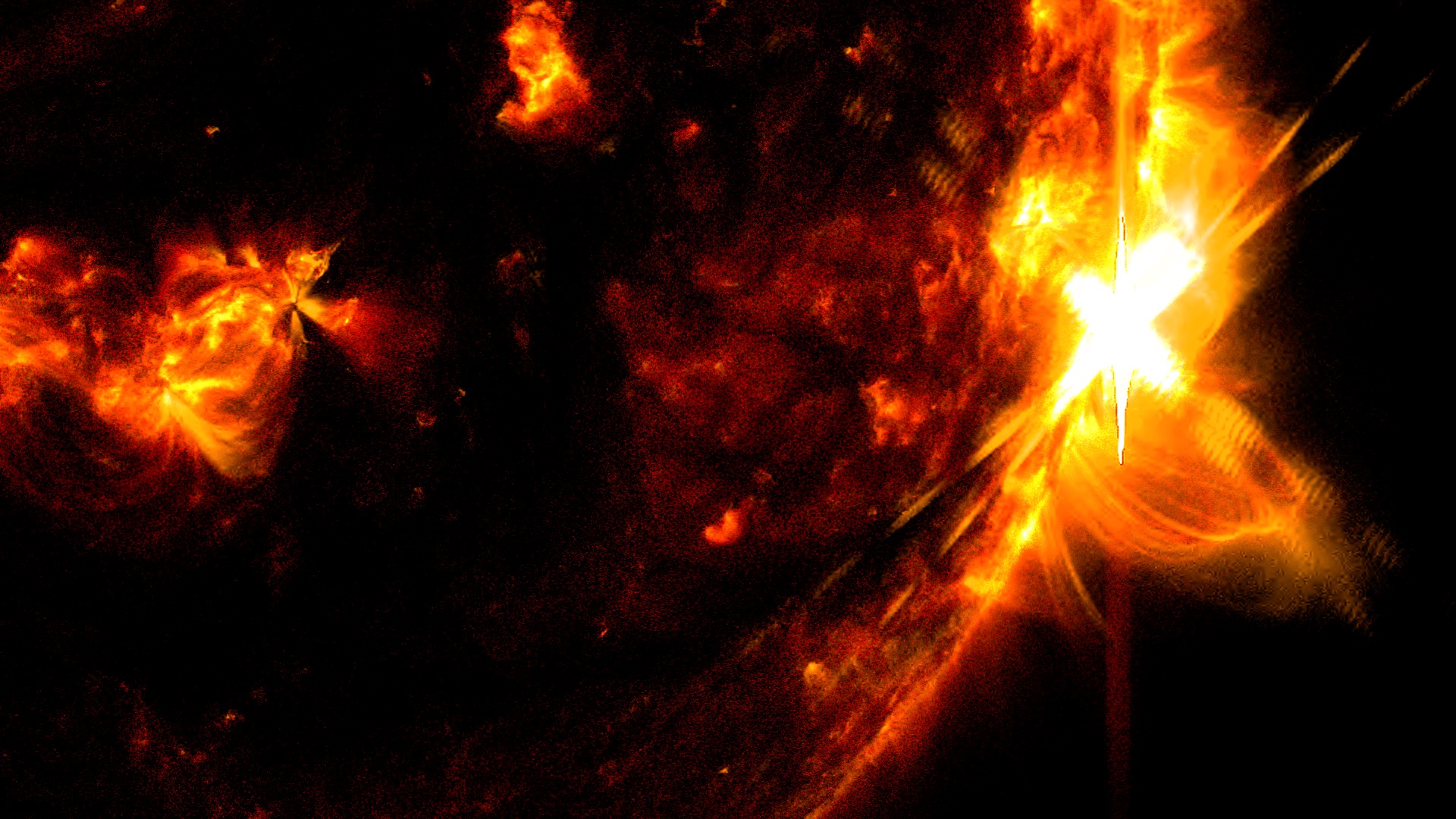

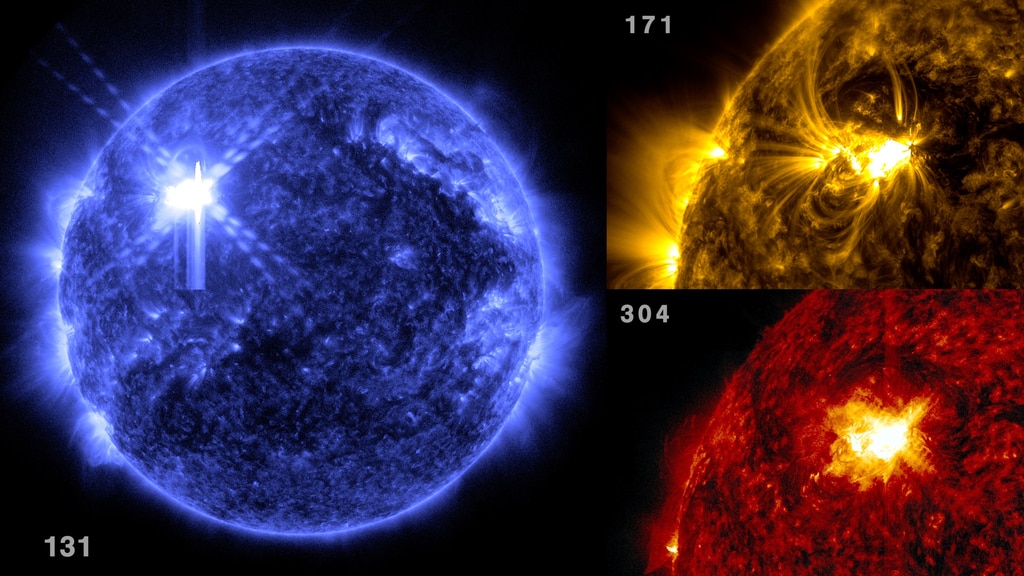
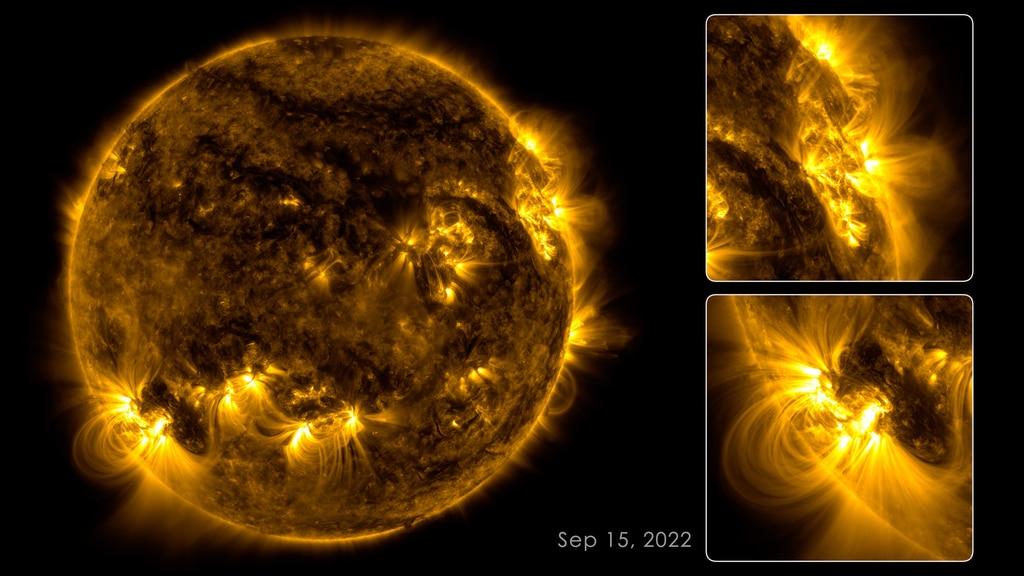

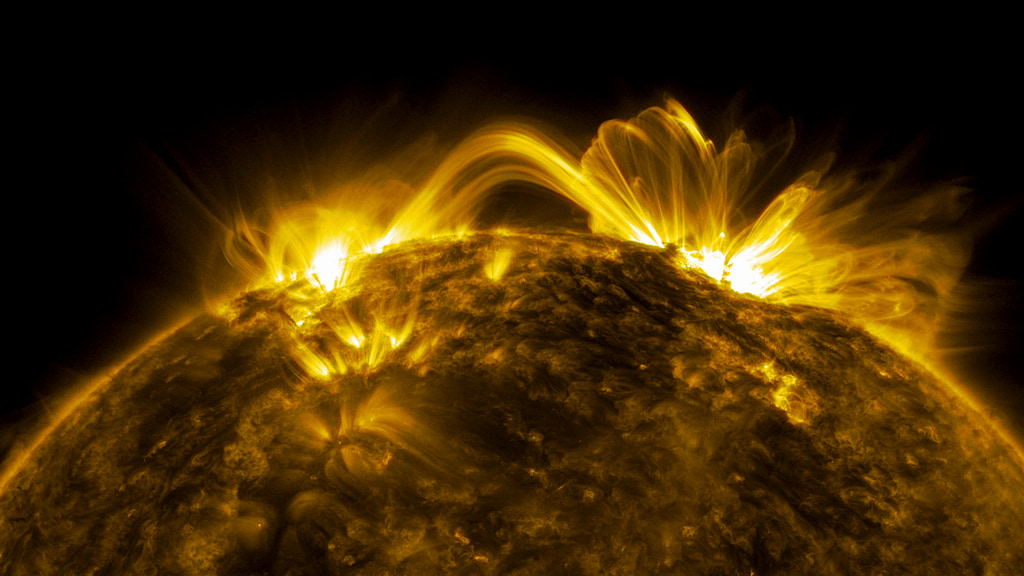


![Music credits: “Swirling Blizzard” and “Endless Swirl” by Laurent Dury [SACEM] from Universal Production Music Watch this video on the NASA Goddard YouTube channel.Complete transcript available.](/vis/a010000/a013800/a013859/13859_SDOColors.00700_print.jpg)

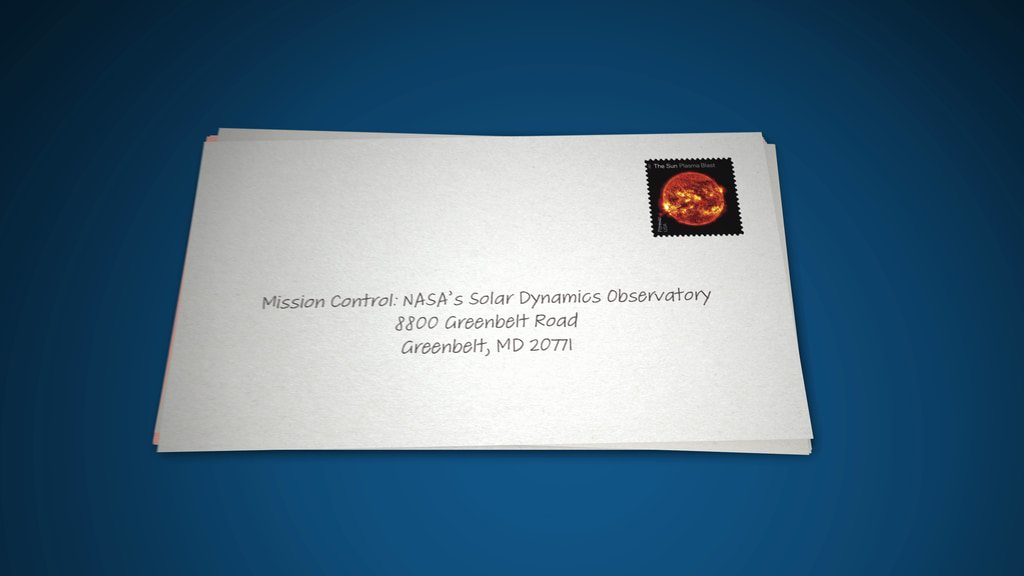

![VIDEO IN ENGLISH Watch this video on the NASA Goddard YouTube channel.The Sun is stirring from its latest slumber. As sunspots and flares, signs of a new solar cycle, bubble from the Sun’s surface, scientists are anticipating a flurry of solar activity over the next few years. Roughly every 11 years, at the height of this cycle, the Sun’s magnetic poles flip—on Earth, that’d be like the North and South Poles’ swapping places every decade—and the Sun transitions from sluggish to active and stormy. At its quietest, the Sun is at solar minimum; during solar maximum, the Sun blazes with bright flares and solar eruptions. In this video, view the Sun's disk from our space telescopes as it transitions from minimum to maximum in the solar cycle.Music credit: "Observance" by Andrew Michael Britton [PRS], David Stephen Goldsmith [PRS] from Universal Production Music](/vis/a010000/a013700/a013716/13716_SolarCycleFromSpace_YouTube.01410_print.jpg)
